Simpsons-Sears Hasbro GI Joe Mountie
Hasbro Canada's Royal Canadian Mounted Police (RCMP) action figure made quite a stir when it first hit department store shelves back in the late fall and early winter of 1966. The Mountie figure was designed to be an extension of the popular "GI Joe Soldiers of the World" action figure series (which debuted earlier that same year), yet the Mountie was only made available to Canadian toy markets. His clothing and accessories were based on an actual RCMP officer's uniform and the amount of detail and accuracy that went into their design marked a high point in GI Joe's multi-occupational career. So much so, that fellow GI Joe licensee, Palitoy, continued to produce a close cousin to the Canadian-made figure for many years following his short two-year life span with Canadian retailers. This Canadian icon is now one of Hasbro's most sought-after vintage GI Joe collectibles.
The text and photos that follow will highlight the details of the GI Joe Mountie's emergence onto the toy scene; provide particulars regarding his uniform, equipment and retail packaging; furnish the reader with close-up photos of commonly misunderstood elements of his uniform; correct any misconceptions that have arisen over time and, finally, differentiate the 1966-1968 Canadian figure from other GI Joe and Action Man Mountie figures issued in foreign markets.


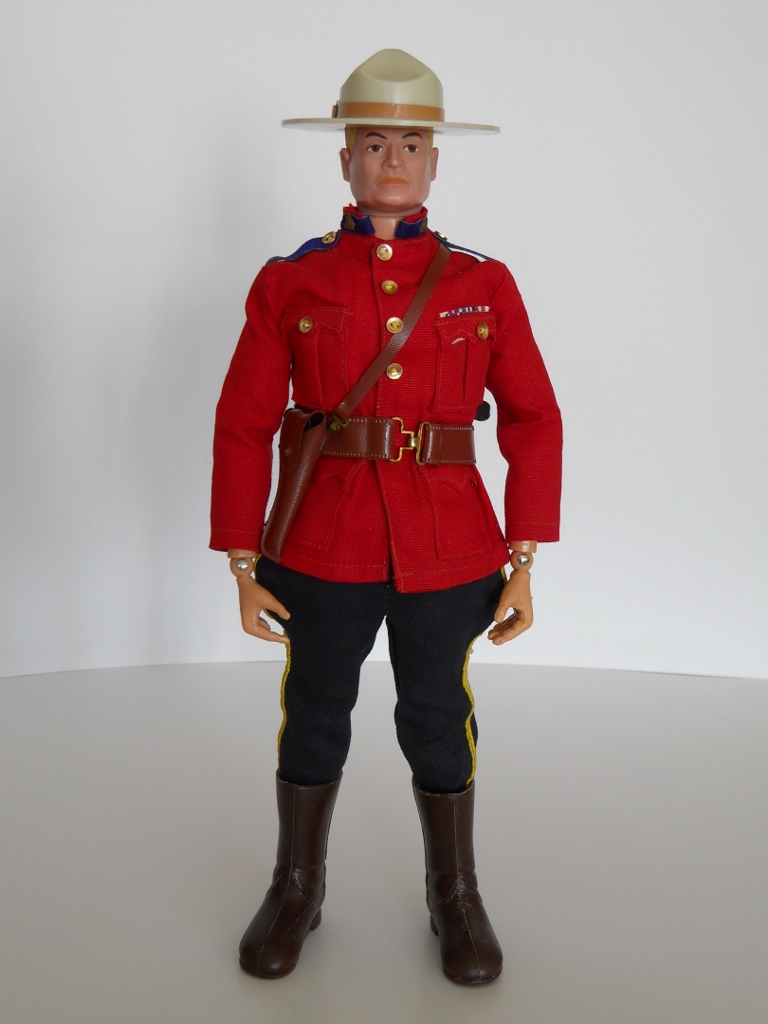
The above photos show two 1966 Hasbro Canada GI Joe Mounties flanking a vintage corrugated shipping box that retailer, Simpsons-Sears, used for packaging the Mountie gift set. Notice the brown jack boots worn by each figure; one indicator that differentiates him from non-Canadian or 1970's Mountie figures.
A Brief Note about Simpsons-Sears
Prior to entering into a detailed description of the GI Joe Mountie figure, it will be helpful if readers understand the tie-in to the Canadian retail department store and catalog sales entity, Simpsons-Sears. Simpsons-Sears Limited was created in 1952 as a fifty-fifty partnership between Canadian retailer, "Simpson's" stores, and American retail giant, "Sears, Roebuck and Company." Both partners injected an equal amount of seed money into the new venture and, shortly following its creation, Simpsons-Sears began distributing three major mail order catalogs each year: Spring/Summer, Fall/Winter and a Christmas issue. Similar in format to American Sears Christmas catalogs, Simpsons-Sears Christmas catalogs contained a large "Toy and Games" section that featured color and black & white drawings (and later photos) of a wide range of toy products. Subsequently, the GI Joe Mountie figure was featured in their Christmas catalogs for 1966 and 1967.
The Complete Encyclopedia to GI Joe
We would like to take this opportunity to thank Mr. Vincent Santelmo for the time, care and attention that he has taken over the years, compiling detailed information on GI Joe and authoring the various editions of his work, "The Complete Encyclopedia to GI Joe." Each edition of this publication has proven to be of immense value to collectors worldwide. Not only has he furnished us with relevant information on the figures and equipment sets issued during each decade of GI Joe's continuing toy lifetime, he has also taken countless hours to chronicle Joe's birth and growth through personal interviews with many of the key players involved in Hasbro's organization. Each edition is well written; sprinkled with loads of color and b&w photos of GI Joe and his accessories; and serves as compelling reading for GI Joe collectors everywhere. These books are indispensable in terms of being outstanding reference sources.
Yet, with respect to the GI Joe Canadian Mountie figure, the various editions of Mr. Santelmo's work do contain several errors which we would like to correct at this time. While many of these are minor in nature, nonetheless, collectors should be made aware of them, especially since these publications will continue to serve as major reference sources for years yet to come.
With respect to the first edition of his work (The Complete Encyclopedia to GI Joe, Copyright 1993 by Vincent Santelmo, Published by Krause Publications), the following paragraph is contained on page 48 regarding the GI Joe Mountie:
"To increase the line of new figure sets for 1967, Hasbro/Canada produced the Action Soldier's Canadian Mountie Set, which included one basic GI Joe uniformed in an authentic miniature outfit of the Royal Canadian Mounted Police. This exclusive gift set came with an assortment of weaponry, mountain climbing gear, and other equipment. The complete package was sold only at Simpsons Sears, Roebuck and Co. in Canada for about $7.98."
The following corrections should be noted:
1.) Mr. Santelmo uses "1967" as the year of release of the Mountie GI Joe. The GI Joe Canadian Mountie figure was actually first released onto store shelves (and, in specific, Simpsons-Sears shelves) in the late fall or early winter of 1966, just prior to the release of the 1966 Simpsons-Sears Christmas catalog. The figure continued to be sold by Simpsons-Sears through both their retail stores and catalog sales until the stock was depleted sometime in 1968. The Mountie figure no longer appears in the 1968 Simpsons-Sears Christmas catalogue.
2.) Mr. Santelmo next states that Hasbro produced the Action Soldier's Canadian Mountie Set. As previously mentioned, the Canadian Mountie was intended to be an extension of the 1966 GI Joe "Action Soldiers of the World" line-up (although boxes indicated that the Mountie was a member of the "Action Men of the World," as the Mountie is not a soldier; he is a police officer). In all three editions of Mr. Santelmo's work, the Mountie set incorrectly appears under the "Action Soldier" category. He should, instead, appear alongside of the German, Japanese, Russian, French, Australian and British figures, which were also first released in the 1966 calendar year.
3.) There is no such enterprise known as "Simpsons Sears, Roebuck and Co." The proper name of the retail and catalog entity was "Simpsons-Sears Limited," the hyphen being omnipresent in the store's name.
4.) The Mountie Gift Set sold for exactly $7.98 in Canadian funds, as price tags on vintage boxes evidence, not "about" $7.98.
On page 186 of the book, photos and a complete listing of the figure's equipment appear alongside additional text. In this section, three of the above errors are repeated and a fourth appears. The text section states:
"His uniform was the same as worn by Royal Mounted Police in British Columbia, . . . " Why only in British Columbia? The RCMP is a federal police force that serves in all provinces and territories of Canada (other than for those with a provincial police force such as Ontario and Quebec).
On pages 48 and 189 of the second edition of the encyclopedia (The Complete Encyclopedia to GI Joe, 2nd Edition, Copyright 1997 by Vincent Santelmo, Published by Krause Publications), the exact same text appears as that contained on pages 48 and 186 of the first edition and, therefore, all the above errors are repeated. In addition, the second edition contains the following new text in the fifth paragraph of page 448:
"Simpsons Sears, who sold the exclusive Canadian Mountie in 1967, had a Christmas order catalog called a Wish Book."
The above sentence makes reference to a Christmas catalog known as a "Wish Book." The true fact is that the Simpsons-Sears catalog (in 1966 and 1967 when the Mountie appeared) was simply known as the "Simpsons-Sears Christmas Catalogue." The Canadian Sears catalogs did not adopt the Wish Book logo on their covers until 1970 (see the Christmas Catalogues section of this website for more insight).
In the 3rd Edition of the Encyclopedia (The Complete Encyclopedia to GI Joe, 3rd Edition, Copyright 2001 by Vincent Santelmo, Published by Krause Publications), the following pages contain errors:
1.) On page 45, the second to last paragraph refers, once again, to the "1967 Canadian Mountie Gift Set," as opposed to the correct 1966-1968 time span.
2.) On page 126, the single paragraph on it makes reference once more to 1967, however the Simpsons-Sears name is now correctly displayed.
3.) On page 212, the book states, in the bold header line, "#5904 CANADIAN MOUNTIE SET 1967 (Gift Box set by Simpsons-Sears, Roebuck and Co.)." To reiterate, "Simpsons-Sears, Roebuck and Co." never existed. Also, the 1967 date appears yet again. The paragraphs near the bottom of the page incorrectly show the Mountie set as part of the "Action Soldier" line-up, the fictitious "Simpsons-Sears, Roebuck and Co." name, and, the Mountie uniform being linked solely to the province of British Columbia.
4.) And, finally, we come to pages 164 and 165 which contain more misinformation. The first paragraph on page 164 contains the following wording:
"EXPO, Canada's Confederation 100th anniversary (centennial celebration) occurred in 1967. To commemorate the occasion, Hasbro-Canada produced the "Canadian Mountie Gift Set" . . . The GI Joe Mountie was considered the seventh character in Hasbro's Fighting Men series."
Although Canada's Centennial did occur in 1967, and, many separate celebrations were held throughout the calendar year to commemorate the event, "Expo" was not the name given to the country's centennial. The word "Expo" refers to "Expo '67" which was held in Montreal that year and was Canada's effort to host the "World's Fair." Furthermore, since the GI Joe Mountie actually hit store shelves in late 1966, was featured in the 1966 Simpsons-Sears Christmas catalog, and, was likely already in the planning stages much earlier in 1966, each of these events lend credence to the fact that the creation of the GI Joe Mountie had absolutely nothing to do with commemorating Canada's centennial. The book is correct however in implying that the Mountie was designed to be the latest addition to the "Fighting Men" (Action Soldier of the World) series.
The third paragraph goes on to call the Simpsons-Sears Christmas catalogue a "Wish Book" again; states that the catalog was issued quarterly, when, in fact, there were only three major issues each year (Spring/Summer, Fall/Winter and Christmas); indicates that the page that the GI Joe Mountie appeared on was dedicated to GI Joe figures, which is not wholly true since Marx Toys' Mike Hazard, Double Agent, also appears on the same page; states that the window display boxed figure sold for $6.98 in U.S. dollars and the closed-box version sold for $1.00 more ($7.98 U.S.?) when, in fact, the closed-box figure sold for $7.98 in Canadian dollars.
And, finally, page 165 states:
"As 1967 came to a close, leftover sets that were not packaged in a box were poly bagged with header card and sold under the banner "Backyard Patrol."
Even though we have no doubt that leftover sets were eventually packaged as Backyard Patrol sets, it is the indicated time of year that is highly unlikely. In late 1967, Simpsons-Sears was still aggressively selling the complete Mountie sets as evidenced by their continued presence in the 1967 Simpsons-Sears Christmas catalogue. These complete Mountie sets would have still been available for catalog ordering up until the summer of 1968 as, on page 158 of the 1967 Simpsons-Sears Christmas catalogue, it states: "Remember . . . You May Purchase Any Toy From This Catalogue Until July 2, 1968." It is more likely that the Backyard Patrol sets were sold off in late 1968, as opposed to late 1967. Having said this, it was evident in the 1967 catalog that the Mountie figure was likely on his way out because the retail price of the Gift Set was reduced from $7.98 to only $5.98.
And finally, before leaving the topic of these guide books completely, there is one other item that should be clarified, although it does not pertain directly to the Mountie. On page 136 of the 3rd Edition of the Encyclopedia, next to a photo of a boxed British Commando figure, the text states: "Since a large percentage of Canadian residents were from Britain, the British Commando was respectfully labeled the British-Canadian Commando."
The labeling on Canadian boxes had nothing at all to do with the percentage of Canadians that originally came from Great Britain. Rather, it had everything to do with the fact that Canada played a major role in the Allied forces during World War II and Canadians were apt to question, "Why did Hasbro produce French, Australian and British WWII figures, but not a Canadian one?" To compensate for this, Hasbro Canada decided to "add" a WWII "Canadian" soldier to the mix. But, because Canada still had very strong ties with Great Britain as part of the Commonwealth during the war, a Canadian WWII soldier's uniform and that of a British WWII soldier were, for all intents and purposes, identical. This made it extremely easy for Hasbro Canada to "add" a Canadian Commando figure to the series; all they had to do was re-label the GI Joe box.
Thus, in the United States, boxes simply read "British Commando," but here in Canada, our boxes actually read "British and Canadian Commando" (not British-Canadian Commando as indicated by Mr. Santelmo). The intent was clear. If you bought one of these figures, you would be able to decide whether or not it was a British soldier or a Canadian soldier, your choice!
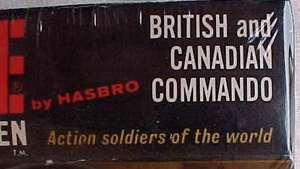
So, in conclusion, one could say that there were seven figures in the Action Soldiers of the World series before the Mountie was issued; they included both a British Commando and a Canadian Commando; but they looked identical. Given this, perhaps the Mountie should now be considered the eighth figure in the series?
Shown below are the covers of the three editions of The Complete Encyclopedia To GI Joe.
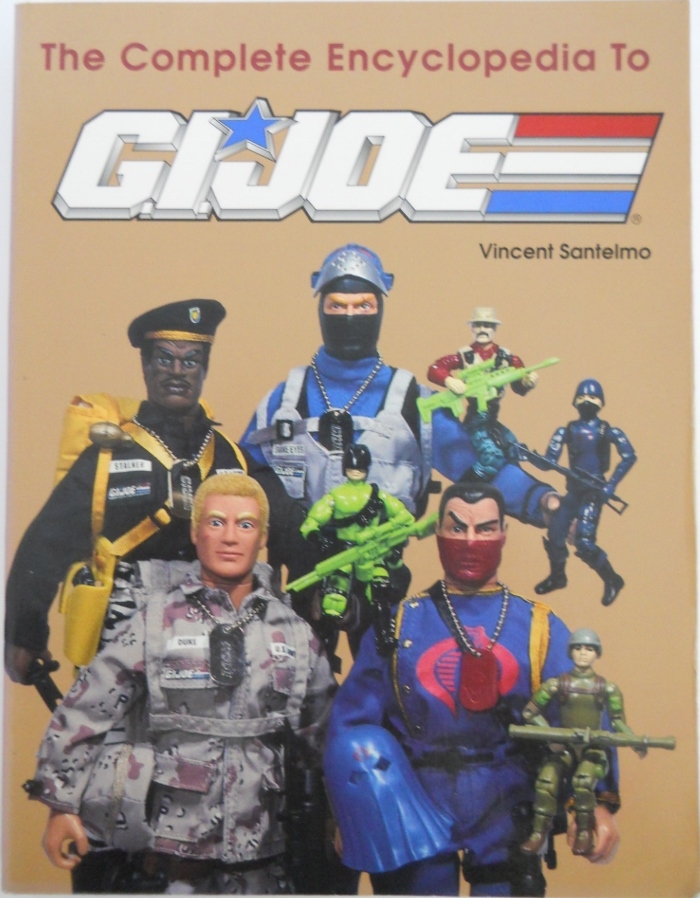


The Mountie Makes the Scene
Most of my earliest memories of the GI Joe Mountie figure are pretty clear (for reasons that will become obvious to you given the frustrations that I encountered in obtaining this, even in 1966, hard-to-obtain action figure).
By the latter half of 1966, I was already a diehard 12-inch action figure collector, having obtained my first two GI Joes at Christmastime in 1964. With the recent release of the six "Soldiers of the World" GI Joe action figures (and my recent acquisition of the Australian Jungle Fighter), my passion for GI Joe was still at an all-time high.
On a day either in the late fall or early winter (likely late October or early November) of 1966, I recall going to the Simpsons-Sears store location in the Polo Park Shopping Center in Winnipeg with my mother. It was not a shopping trip as she simply had some business to do at the Simpsons-Sears Service Desk counter, likely to make a payment on our family's Simpsons-Sears credit card. I remember that she was in a bit of a rush and was trying to hustle me through the store as quickly as possible.
However, as it turns out, the Simpsons-Sears Service Desk was located in the far north-west corner of the store, directly adjacent to the Toy Department, which ran along the west wall of the store and infiltrated into the same area as the Service Desk.
The Service Desk was located in an "L-shaped" jog and, as one approached this area, you had to make a quick turn to the right from the main aisle to enter it. Lined up in the central portion of this area were two or three rows of shelving with products on them that could either be ordered from the Simpsons-Sears catalogue, or, purchased immediately from these displays.
As we turned the corner into the Service Desk area, my eyes immediately caught sight of a row of GI Joe window boxes sitting on the top-most shelf of one of the central rows of shelving. I could make out the bright red jackets, even at this distance, and I instantly made the connection that they were most likely Mountie figures, something that I had absolutely no idea existed in the world of GI Joe at that point in time.
But, as fate would have it, my mother made me accompany her to the Service Desk and would not allow me to stray back into the toy aisle to examine these action figures at a closer range. When I protested, she gave me the standard line that most parents likely used at the time, "Don't worry, Christmas is coming soon and perhaps Santa will bring you a surprise." (A little bit of injected sarcasm as, at my age, I was already well aware that there was no such thing as a "Santa.") Still, I was determined to learn more about these figures and I then implored her to ask the man behind the Service Desk for a copy of the current Christmas catalog; which she did comply with, yet, sadly to no avail. The catalogs were not in stock, however the Simpsons-Sears employee was kind enough to put in an order for a catalog pick-up when they next became available.
I recall next that, weeks later, a notice arrived in the mail telling us that our Christmas catalog was there and waiting to be picked up. Yahoo! This was my chance to take a closer gander at the Mountie action figure and learn more about him.
When my mother and I arrived at the store, much to my chagrin, the Mountie figures were no longer lined up on the top shelf of the central row of goods on display. When I scoured all of the shelves in the vain hope that a Simpsons-Sears employee had moved them to another area, the sad realization hit me; the Mountie GI Joe was already, weeks prior to Christmas, SOLD OUT!
Dejected, I took our family's copy of the 1966 Simpsons-Sears Christmas catalogue home, only to pour over page 61 of the Toy section, over and over again, in the faint hope that the Mountie GI Joe might make his appearance under my Christmas tree on December 25th.
On Christmas morning, I hurried to the stack of gifts under our Christmas tree in search of GI Joe sized boxes with my name on the gift label. Although most were not promising, there was one box in particular that seem to offer great expectations in terms of adding the GI Joe Mountie to my growing collection of 12-inch troops.
Although not the size of a window-boxed figure, the gift box was large enough to hold a 12-inch action figure. You can image my continued disappointment when I opened up my gift, only to discover that it was a Marx Mike Hazard, Double Agent, action figure. (Although, I have to say that Mike Hazard, with his cool trench coat and 60 other pieces of neat spy stuff made the bitter pill much easier to swallow.)
My parents sensed my disappointment, as they had tried to order a Mountie figure for me by Christmas day, but they discovered that the Mountie remained an out-of-stock item and was still on back-order.
But, a few weeks later, my dreams finally came true. Simpsons-Sears received another shipment of Mounties and I became the lucky owner of a spanking, brand new GI Joe Mountie figure, complete with all accessories.
Yet, the figure that I became the proud owner of was not entirely the same as the one that I glimpsed at in the Simpsons-Sears store. Gone was the cellophane wrapped window box. Instead, my figure came in a corrugated shipping box with a pasted-on paper label on the front cover.
Still, the figure and accessories were everything a young boy might desire. The GI Joe Mountie became my favorite 12-inch action figure in the months to come, actually surpassing my love for Johnny West (and Johnny is yet a whole other story).
Illustrated below are four photos that will provide you with a 360 degree view of the 1966 Mountie.
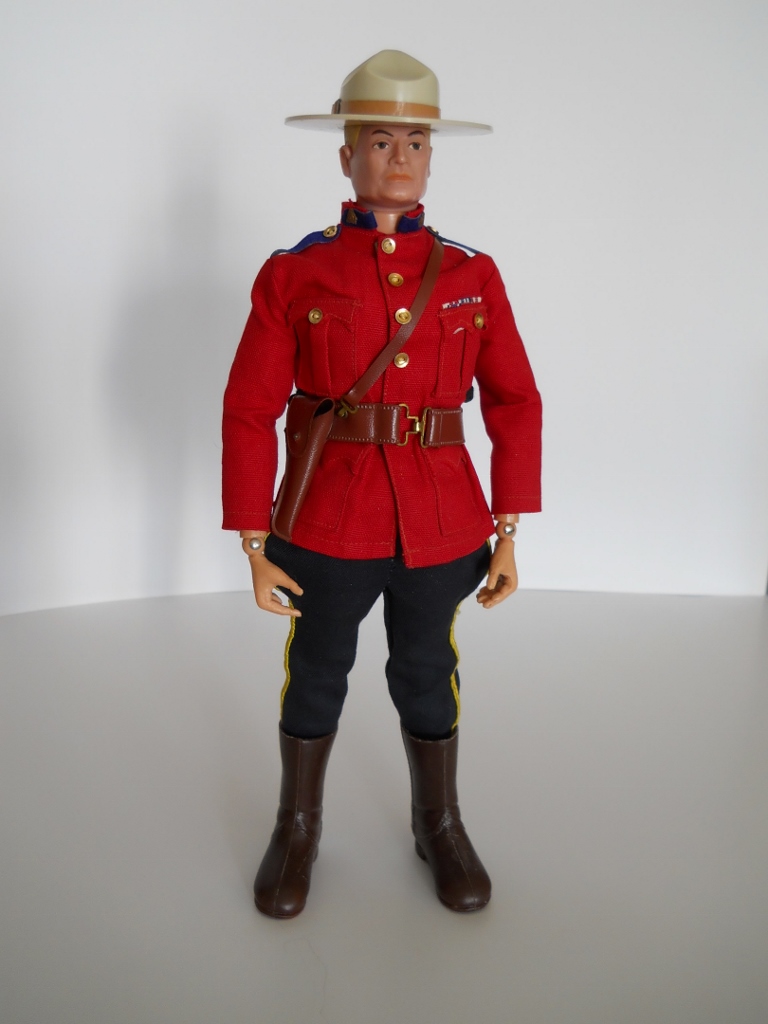
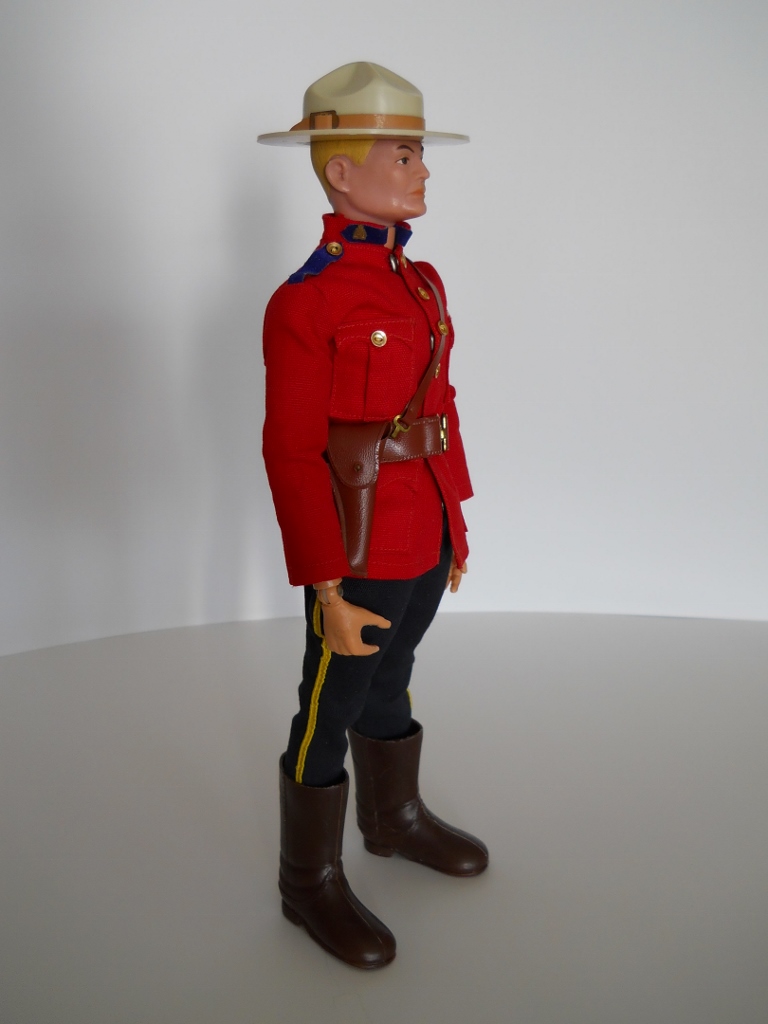

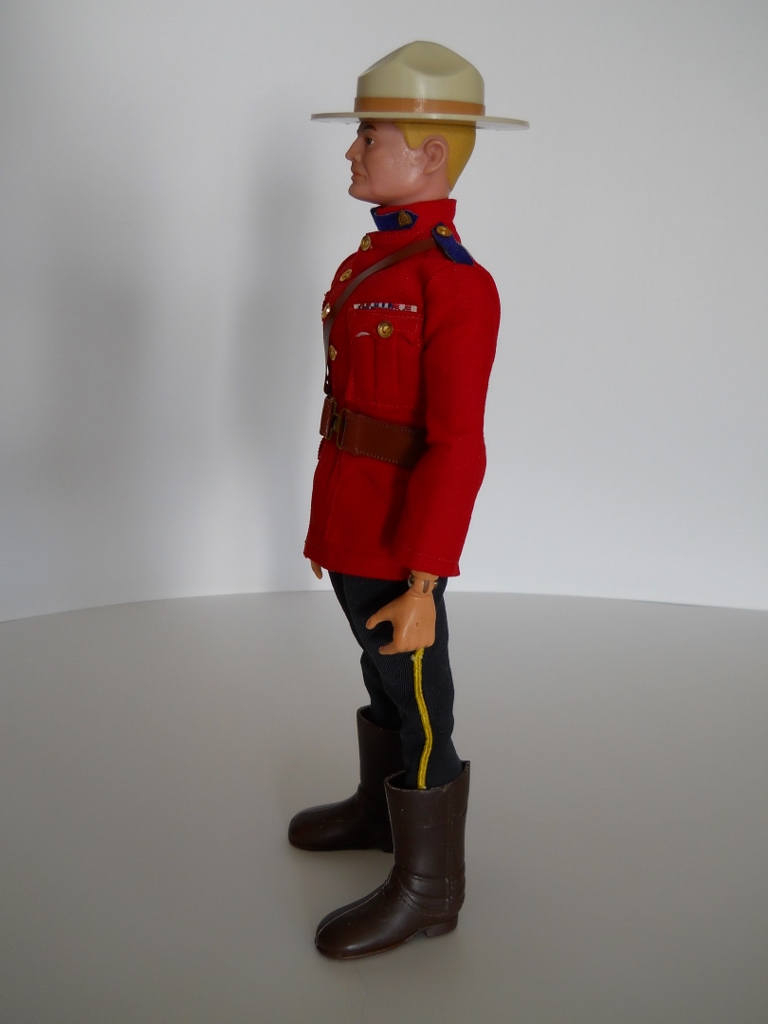
The 1966 Simpsons-Sears Christmas Catalogue
Illustrated below are photos of the front cover of the 1966 Simpsons-Sears Christmas catalogue (the GI Joe Mountie's catalog debut) and a close-up of page 61 showing the Mountie ad in full color. Note that the retail price of the Mountie gift set was $7.98 in Canadian dollars. Also note that, at time of publication, the Mountie figure shown in the ad was obviously still a prototype. He has a leather Sam Browne belt, as opposed to a vinyl one; a standard black GI Joe gun holster, as opposed to a brown vinyl one; black boots, instead of the production brown jack boots; and round Hasbro GI Joe jacket buttons and buttons on his collar, as opposed to the proper gold buttons and "Buffalo head" collar badges.
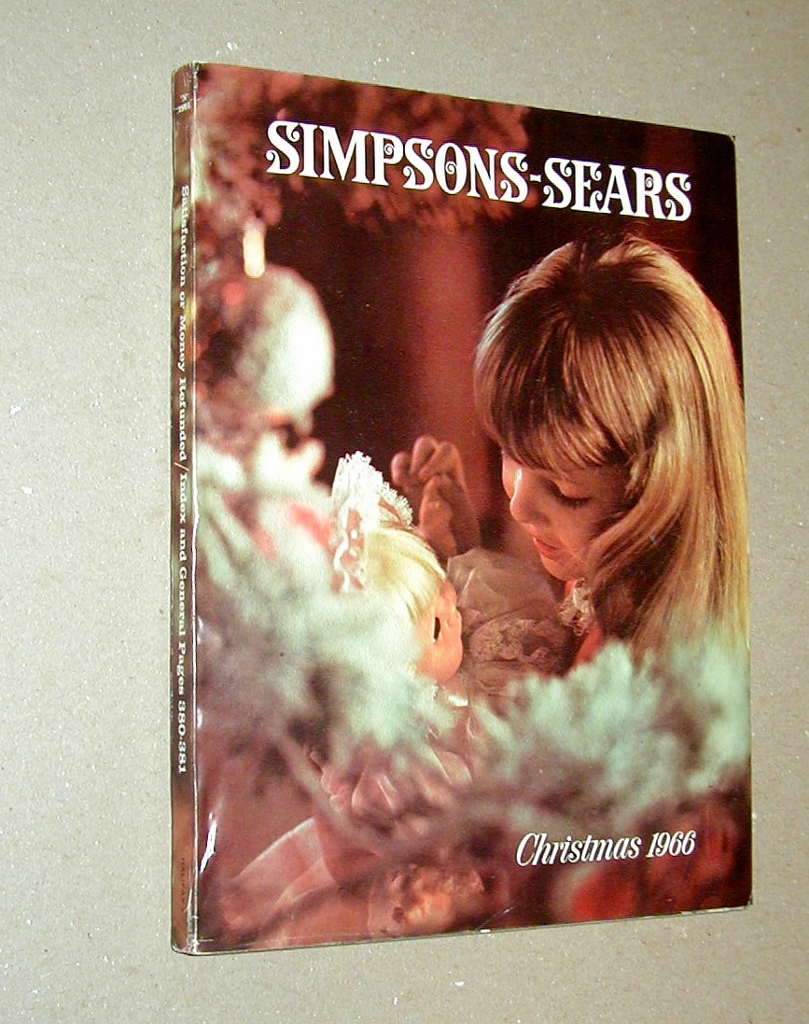

Shown below is a photo of the full page 61, along with a partial view of the facing page 60 of the catalog. Note the presence of Marx's Mike Hazard on the same color page as the GI Joe figures, and, the presence of Johnny West, Chief Cherokee, Thunderbolt and Stony Smith, all Marx 12-inch action figures, on the opposite page. It can also be noted that Stony Smith was making a return appearance from the 1965 Simpsons-Sears Christmas catalogue. Except, for his sophomore appearance, he returned as a "bend-leg" figure as opposed to the "straight-leg" Stony pictured in the 1965 book. And, finally, we should also point out that the description underneath the Hasbro SOTW figure reads simply "Canadian Commando Set" and no reference to a British Commando appears.

Although the above photo does not clearly picture it, the wording for the Mountie figure appears on the facing page near the bottom and reads as follows:
"MOUNTIE SET - Realistically detailed full dress uniform, accessories - (Item) F - Exclusive 'mountie' figure can take many action poses. Dressed in Red coat with epaulets. Navy blue jodhpurs with Yellow piping, hat, boots and Sam Brown belt. Equipment includes revolver, dark glasses, binoculars, night stick, snowshoes, gun belt, radio, earplugs, rifle, climbing stick, canteen, water bottle, knife. Mountie can take as many action poses as G. I. Joe doll, and the uniform can be used by Mountie and G. I. Joe. 11 1/2" tall. - (catalog number) 49 N 38 074 - Gift set . . . . . $7.98."
It's rather amusing reading this ad, everything from the misspelling of the Sam Browne belt to the description of the radio's earphones as "earplugs." But the best quote is the mention that "(the) Mountie can take as many action poses as (a) G.I. Joe doll, and (that) the uniform can be used by (the) Mountie and G.I. Joe." Well, duh, of course, it'll fit; he was a G.I. Joe! (and an action figure, too, not a doll!)
The 1967 Simpsons-Sears Christmas Catalogue
Shown below is the front cover of the 1967 Simpsons-Sears Christmas catalogue, along with a photo of page 183 of the catalog which featured GI Joe. You'll note that, not only has the price of the Mountie Gift Set dropped from $7.98 to just $5.98 (they were likely beginning to clear them out), but gone are the beautiful full color photos which have been replaced by dull black and white images.
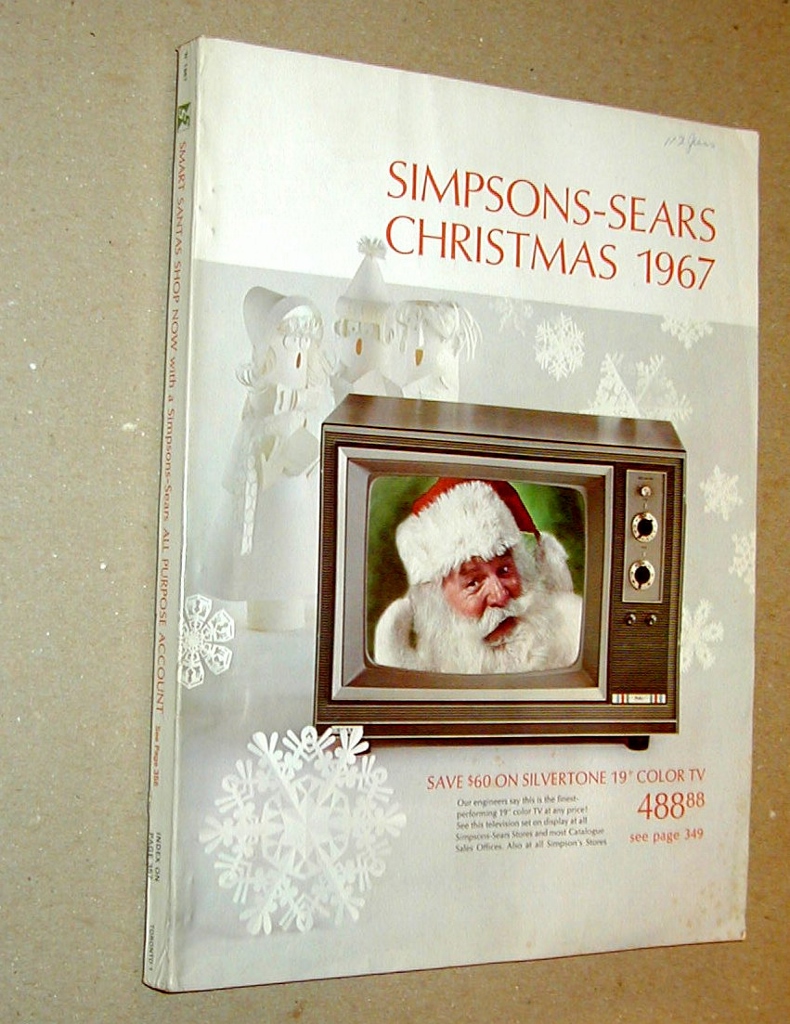
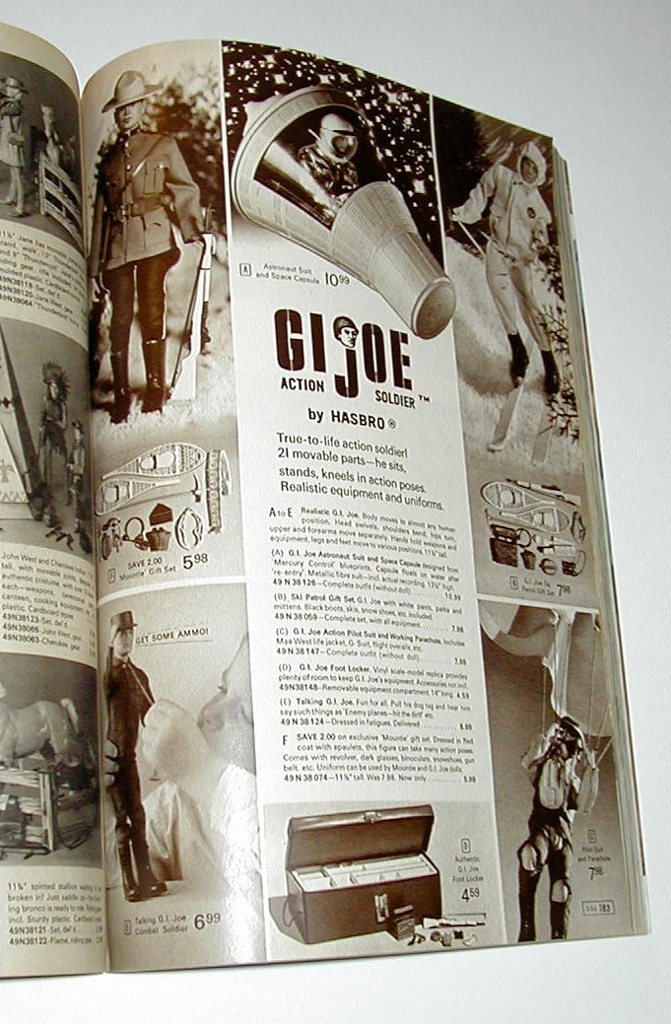
The ad wording for 1967 reads as follows:
"(Item) F - SAVE 2.00 on exclusive 'Mountie' gift set. Dressed in Red coat with epaulets, this figure can take many action poses. Comes with revolver, dark glasses, binoculars, snowshoes, gun belt, etc. Uniform can be used by Mountie and G.I. Joe dolls. - (catalog number) 49 N 38 074 - 11 1/2" tall. Was 7.98. Now only . . . . . 5.98."
The black and white photo now shows the actual uniform with a matching brown vinyl holster, proper gold jacket buttons and the correct RCMP collar badges. What is interesting to note is that the Mountie's hat is missing its hatband. I guess even back in those days, those pesky things would slide off and get lost!
The 1966 Simpsons-Sears GI Joe Mountie in Greater Detail
In this section, we will examine the GI Joe Mountie's uniform and equipment items in detail and, hopefully, dispel any misconceptions regarding these various elements of the original 1966 Mountie. We will also take a look at the Simpsons-Sears corrugated box that figures were shipped in. I have used photos of two of the Mountie GI Joes from my collection as models for this section and, that being the case, there will be subtle differences in several of the photos due to differing signs of wear from age, corrosion and the like.
a.) The Boots
Shown below are two photo views (from front and back) of the Mountie riding boots. These boots were identical, in every way, to the boots worn by the SOTW Russian and German figures, other than for the fact that they were molded in dark brown as opposed to black.

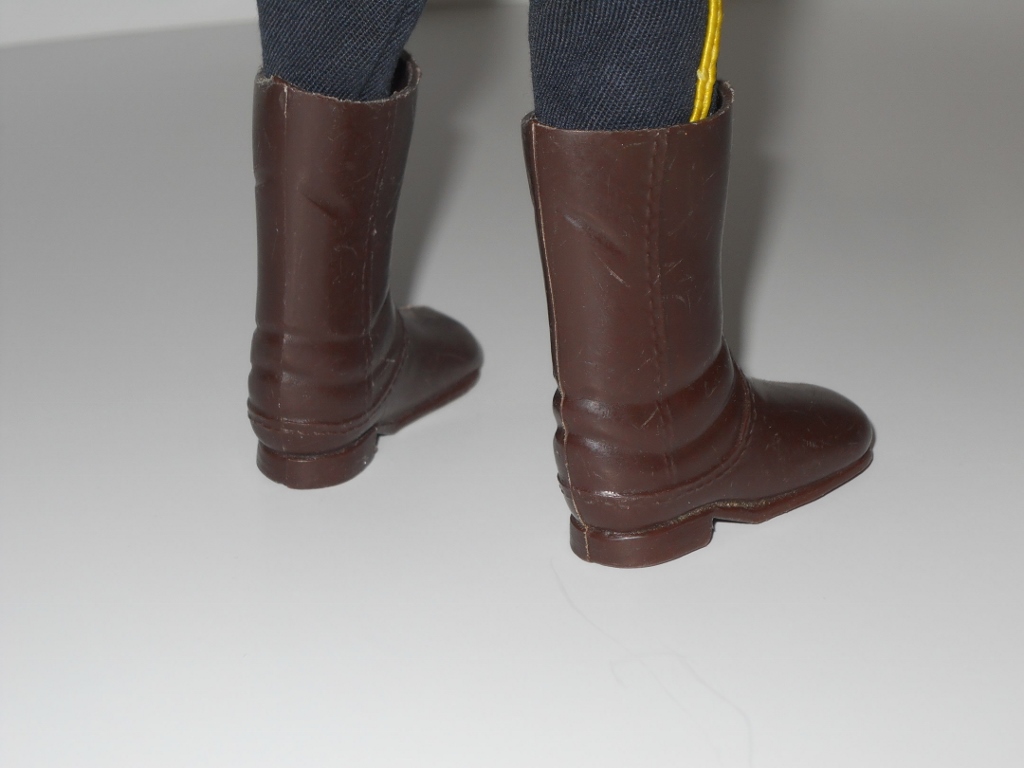
b.) The Jodhpurs (Pants)
The navy blue jodhpurs worn by the original 1966 Mountie were of excellent quality. The material they were made from tended to be a bit thicker than other GI Joe fabrics used at the time. Of all of the original Mountie pants that I have seen (and I have seen quite a few), all of them were tagged with an embroidered GI Joe tag that read: "R., G.I. Joe, By Hasbro, Japan." Also, the yellow piping down the side of the legs tended to be a bit thicker than later Palitoy Action Man versions, and, they are a very bright yellow, as opposed to some of the duller tones issued on the British figures. Possibly the best "tell" that the pants are original is not the fabric, color or the cloth tag, but it is the metal closure snap located at the top of the pants. On all of the Simpsons-Sears issued jodhpurs, the metal snap was the standard "square" snap, but it was colored in a blackish tone, as opposed to the bright silver snaps on all other Joe uniforms of that era. If it has a round snap, it is likely Palitoy; if the snap is silver, the snap may have been replaced; but, if it is black, you most likely have an original pair.
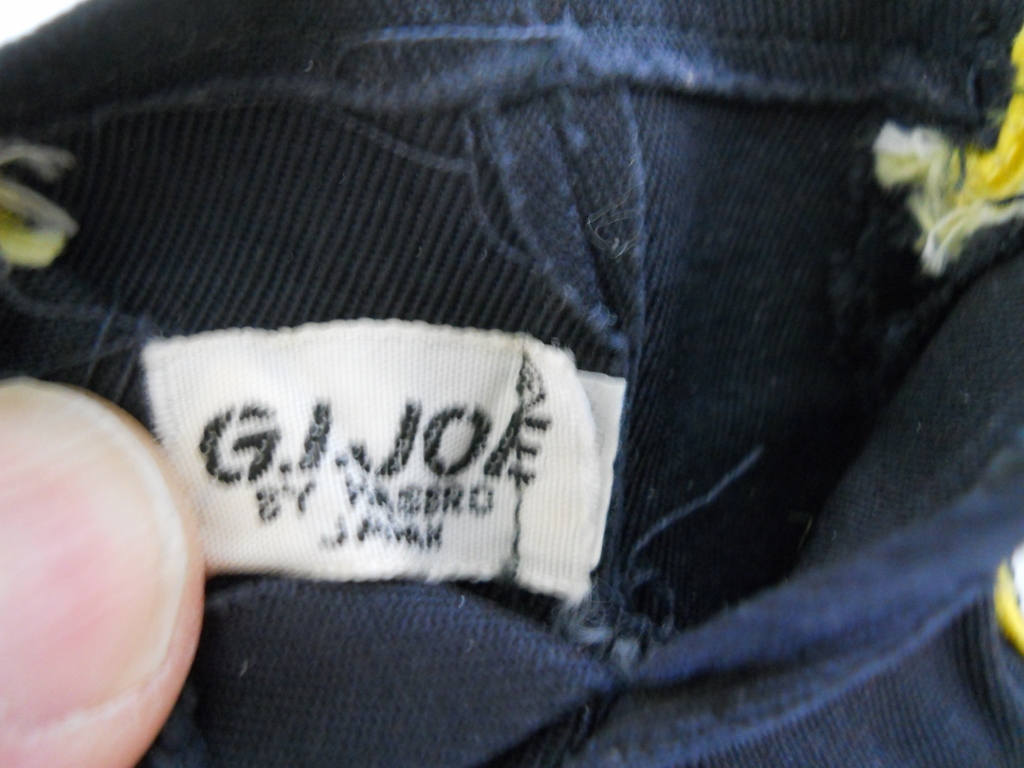

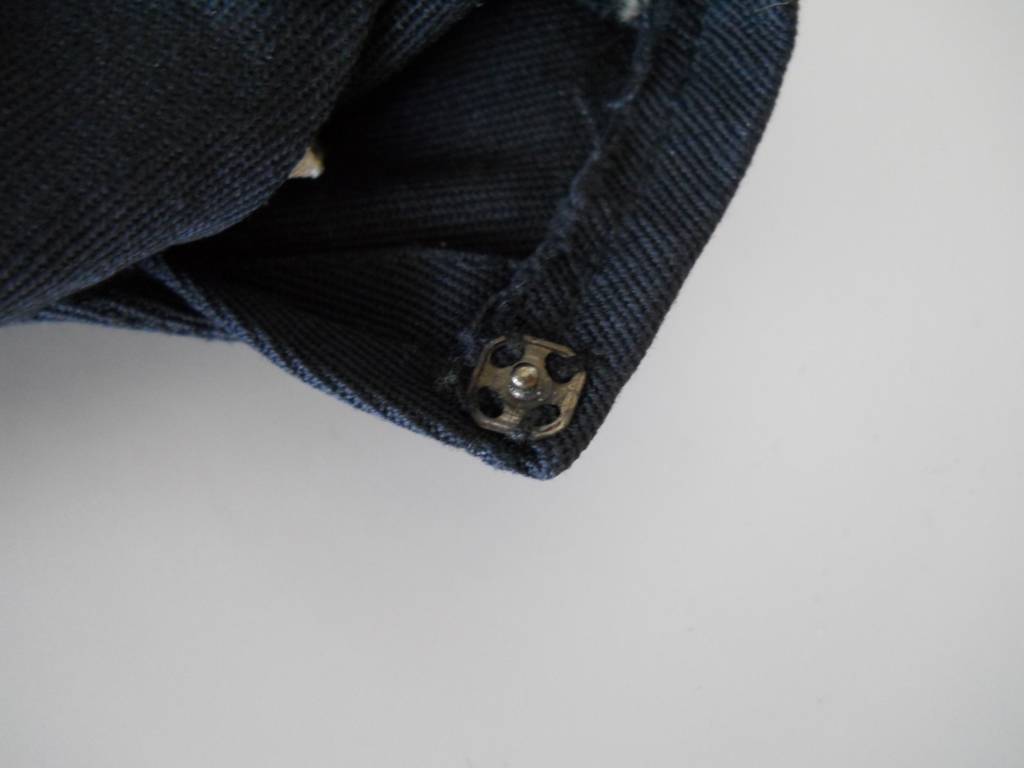
c.) The Jacket
The red regimental dress jacket worn by the Simpsons-Sears Mountie is, in many ways, very similar to later Palitoy versions in terms of the sewing and the weight of the fabric. But there are many other features on the original jacket that differentiate it from subsequent versions.
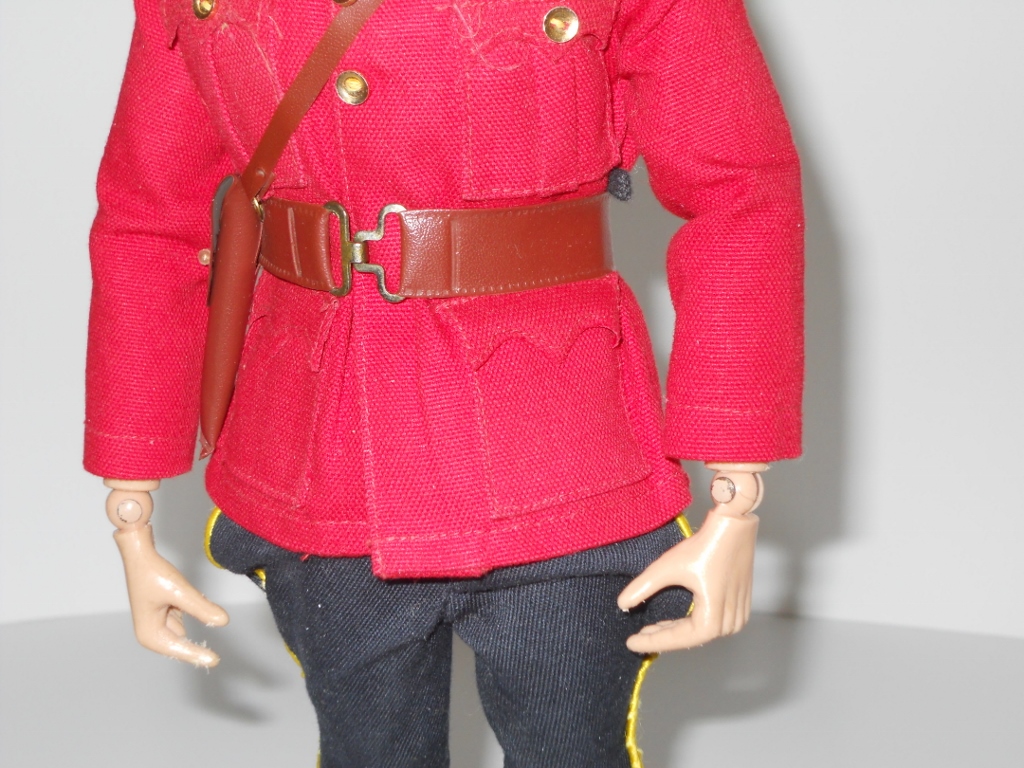
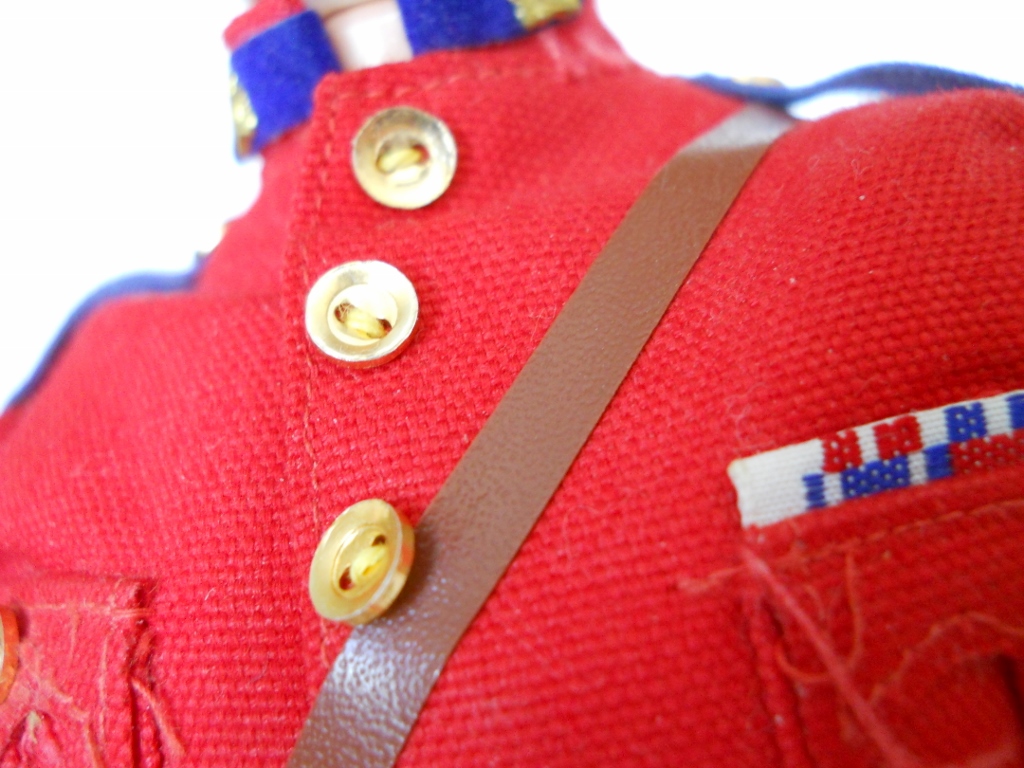
The most obvious feature would have to be the gold buttons located on the front flap, breast pockets and epaulets. These buttons had a very unique and different look from all later Mountie buttons. The gold buttons on the 1966 Simpsons-Sears Mountie (and only on this Mountie figure) were rounded with a distinctly sunken center. I like to call this version of the Mountie buttons the "Cereal Bowl" buttons as they look like tiny kitchen cereal bowls.
The buttons were of identical size and the jacket would have originally had eight of them: four in a row on the front jacket flap, two on the front flaps of the pockets, and two on the inner edges of the epaulets. All of the buttons would have been attached with yellow thread.
Similar to the pants, all of the original jackets would have had an embroidered tag that also read "R., G.I. Joe, By Hasbro, Japan."

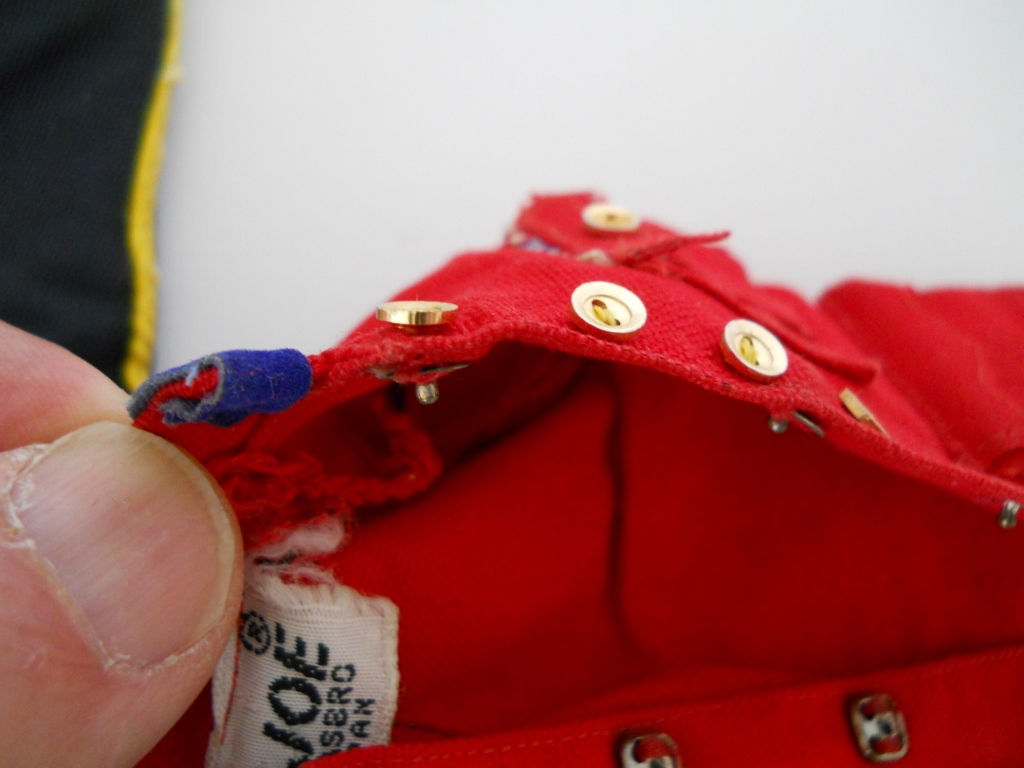
The next feature that can be differentiated from Palitoy versions (although with a bit of required close scrutiny) are the collar emblems.
Illustrated below is a picture of an actual Royal Mounted Canadian Police emblem in full color. Next to it is a close-up photo of one of my original Mounties.

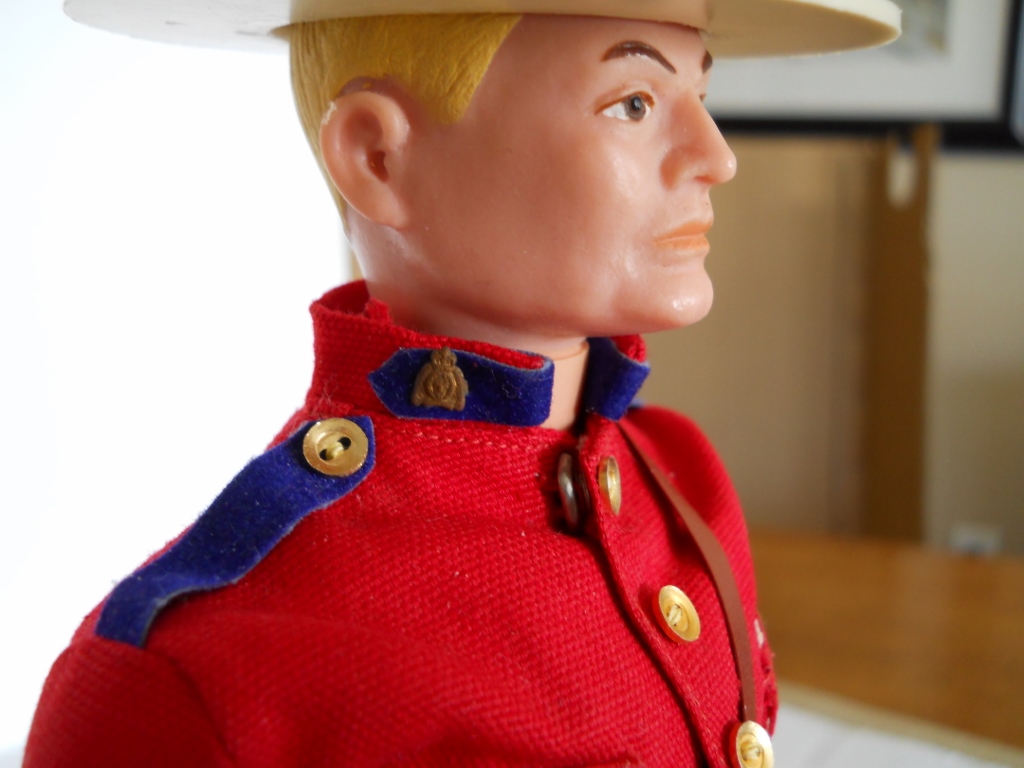
You can see the direct resemblance to the actual emblem. The collar badge on the above Mountie figure has become tarnished with time, but the photo on the left below is of another one of my figures where time and age have not tarnished the metal badge. Next to it is a photo of the other side of the above figure. Although one has tarnished badges and the other doesn't, both are authentic original emblems. I will discuss the differences to Palitoy and GeyperMan collar badges later on in this article.

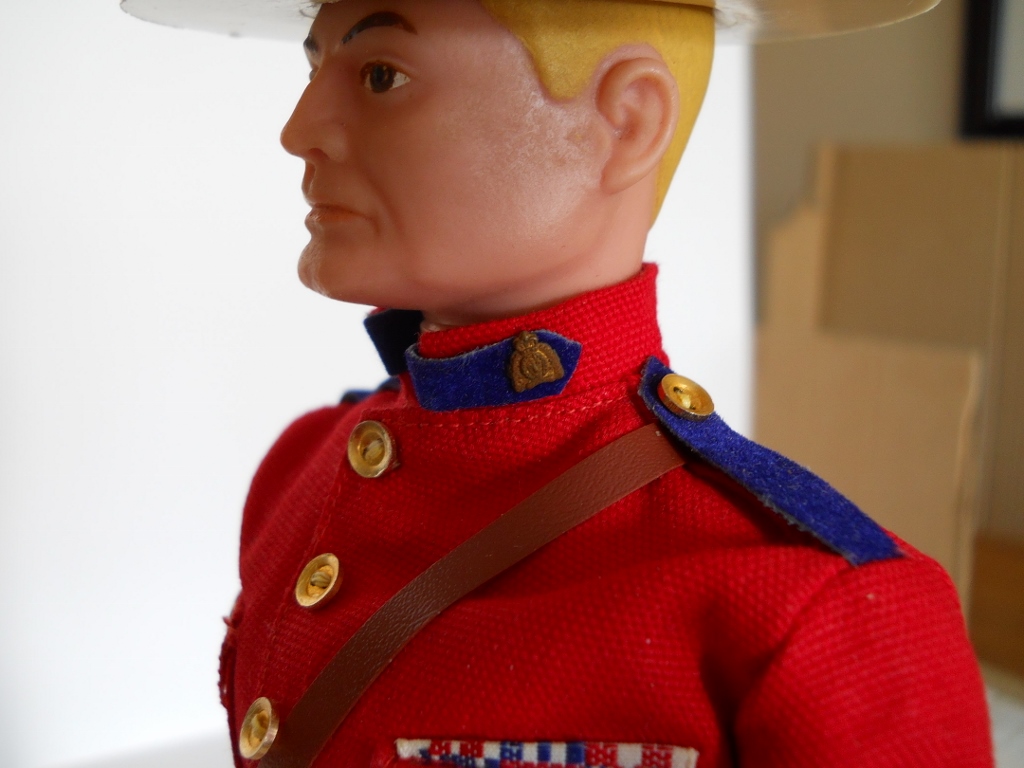
d.) The Sam Browne Belt with Shoulder Strap
It is extremely hard to differentiate between a Palitoy issue vintage Sam Browne belt and an original 1966 Simpsons-Sears belt. Both belts have a similar structure and composition. The metal buckles on the belts are identical. The only very slight difference that I have noted is the fact that the Simpsons-Sears belts tend to be made from a slightly thicker vinyl material than the Palitoy versions. Also, the section where the belt flaps are turned back and heat-stamped may be slightly different, but the variance is really subtle. The shoulder straps and clasps are virtually dead identical and I would challenge anyone to be able to find a discernible difference in the shoulder straps.
The one feature that seems to be a probable indicator though is the holster. Although Palitoy holsters and Simpsons-Sears holsters are also similar in composition, I have never seen a Simpsons-Sears holster that was oriented to sit on the Mountie's left hip. Yes, Palitoy holsters can be either right or left, but the original Simpsons-Sears holster was modeled directly from Hasbro's black vinyl holster that was included with the MP, Shore Patrol and other 1964 figures. Every 1966 Mountie that I have seen, or had, has come with a holster that sits on the right hip (with the pistol's handle facing the rear). If the holster sits on the right, it may or may not be an original belt, but, if it is a "left" hanging holster, you can likely be sure that it is a later Palitoy, GeyperMan or other foreign issue belt.
e.) The Revolver and Lanyard
The revolver that came with the Simpsons-Sears Mountie was the standard six-shot revolver that came with the French Resistance Fighter and, later still, with many of the Adventure Team figures. The only two differences from those pistols to the Mountie gun were the holes drilled into the handle and the presence of the lanyard string. The photo below shows the revolver and the remains of a lanyard string that was cut (and is likely incomplete in terms of length). Later Palitoy lanyards were often made of an elasticized material as opposed to common string.
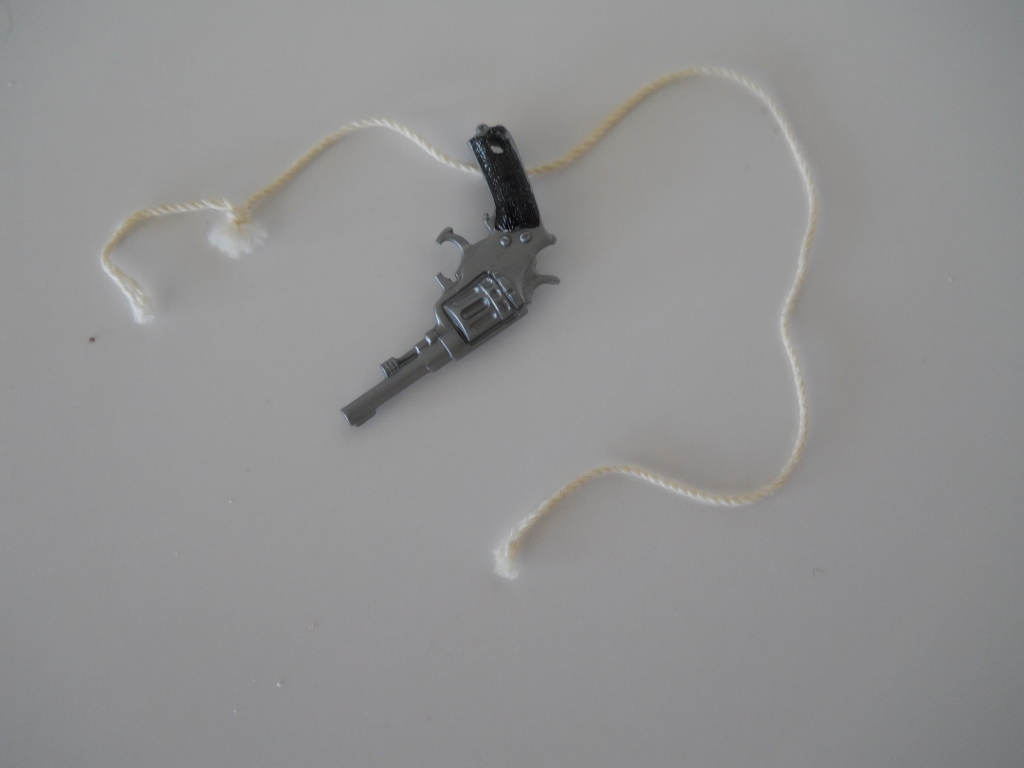

(Note: The trigger guard is, unfortunately, broken on the above pictured revolver; it is not in its original state.)
f.) The Hat and Hat Band
The Simpsons-Sears Mountie hat was made from a much softer plastic than later Palitoy or other Mountie hats. Palitoy and other foreign-issue hats were made from hard, brittle styrene plastic (like the plastic model kits are made from). The Simpsons-Sears hat is much more pliable, or, would be except for the fact that the hat is molded in a much thicker manner. You can see a defined flat edge around the brim, whereas Palitoy hats tend to be somewhat rounded at the edge of the brim.
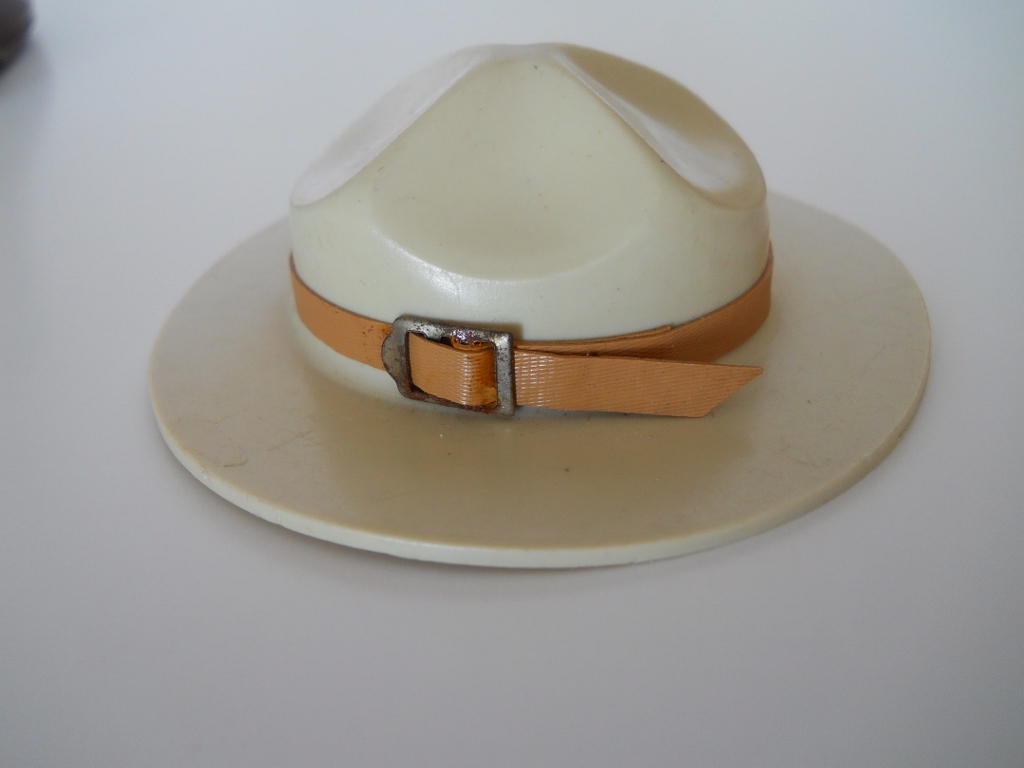
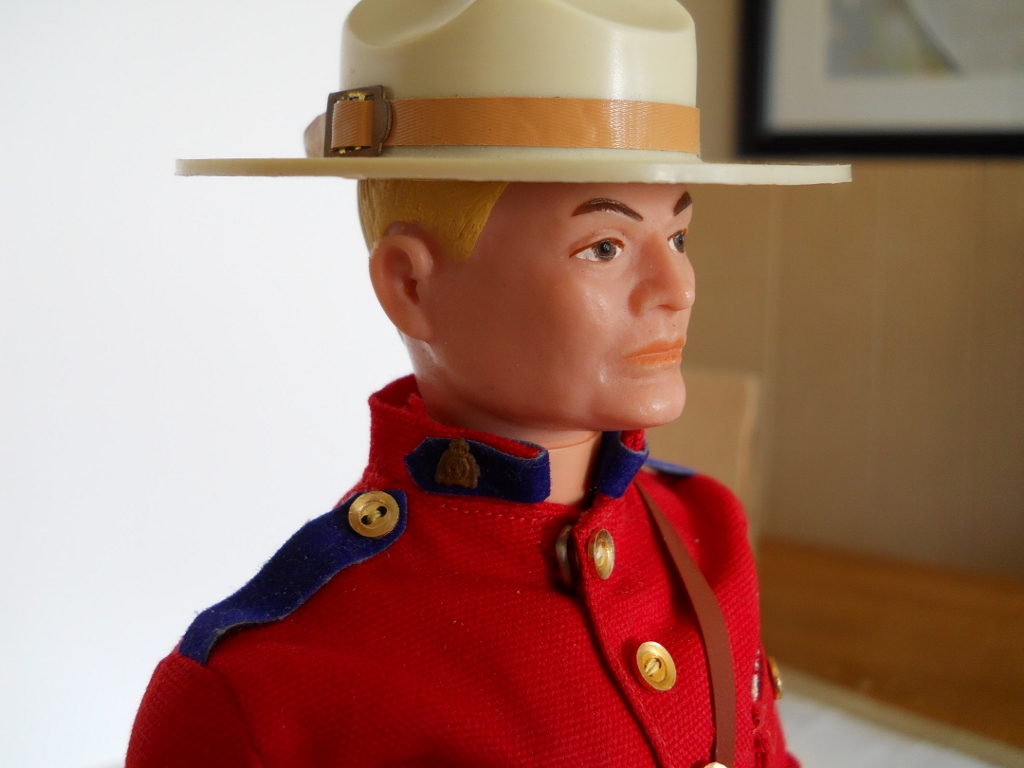
The interior of the Mountie hat is stamped with the following logo, "Hasbro R, Japan."
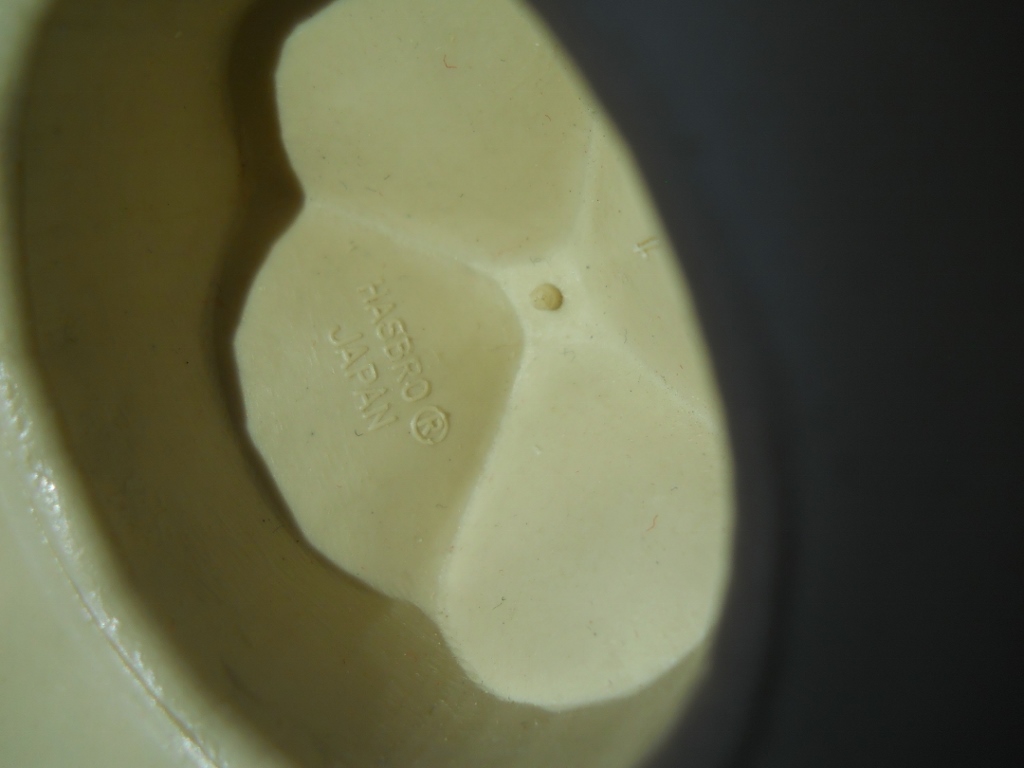
In a similar fashion to the Mountie's jacket buttons and collar badges, the Mountie's original hat band had distinctive and unique features, too. The following close-up illustrates this.
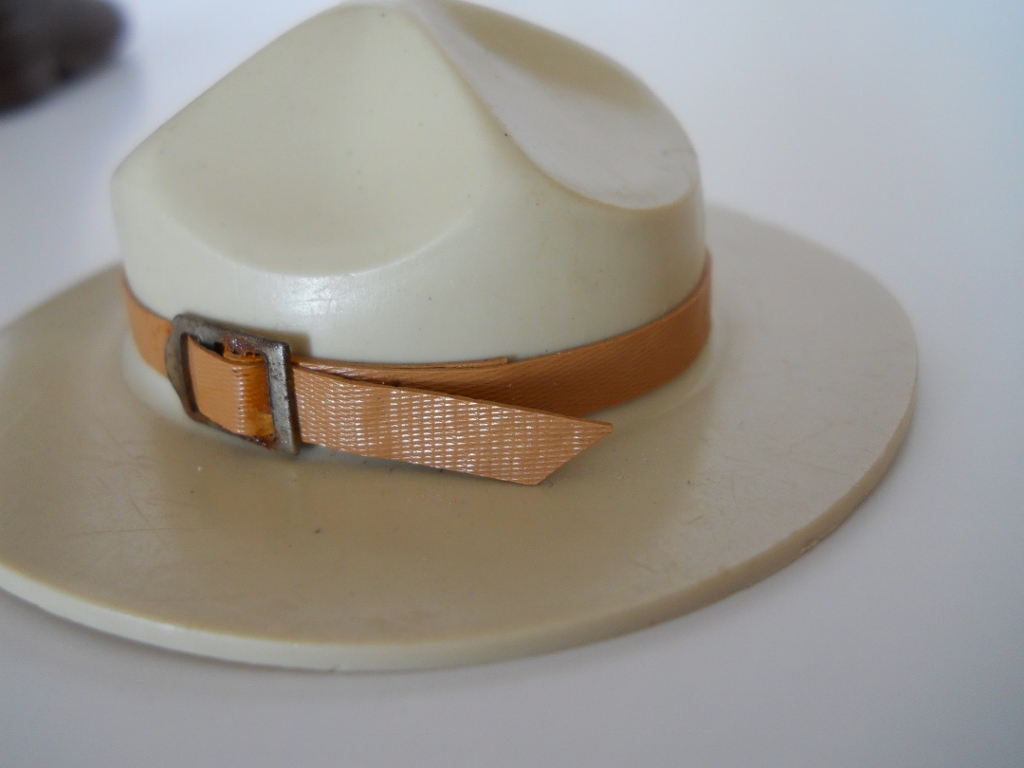
The pattern on the hat band is one of distinctive opposing diagonal lines that form hundreds of tiny "diamond" shapes embedded in it. The Simpsons-Sears hat band is totally different from Palitoy Action Man hat bands that tend to have a slightly raised pattern on them that looks much like random "giraffe" spots. Other vintage Mountie hat bands may be smooth and have no pattern at all, such as European "Action Team" hatbands. The following sketch illustrates this.
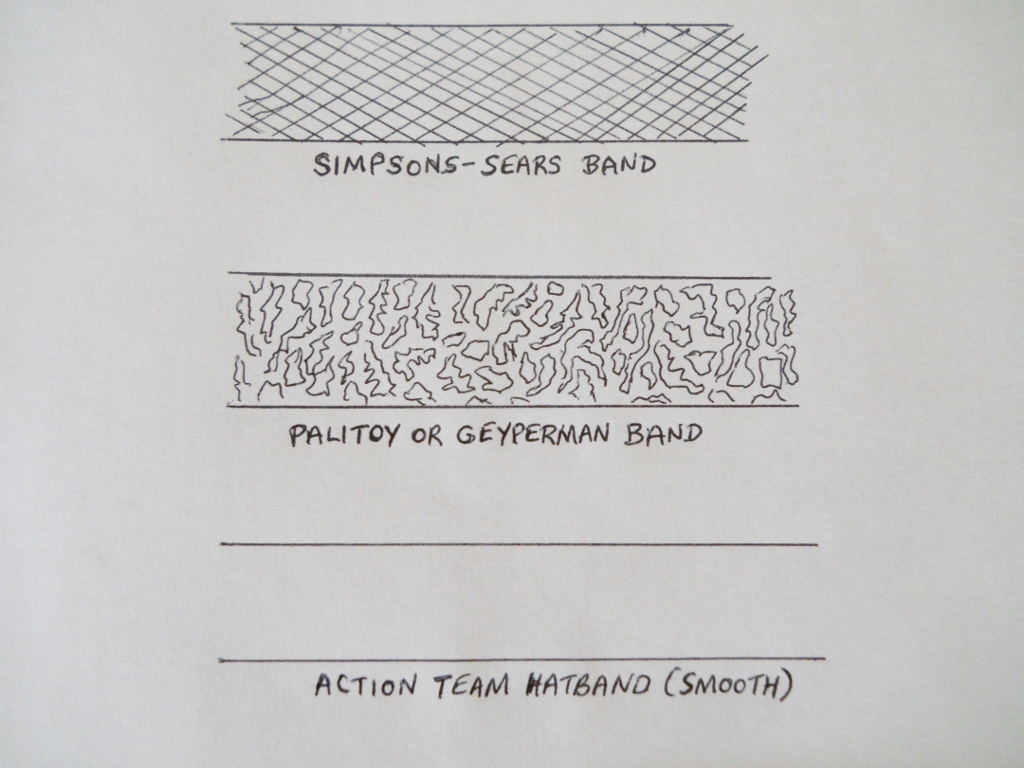
g.) The Accessories
The image below shows the standard equipment items included with the GI Joe Mountie. All of these items were already available with other GI Joe action figure sets and none are unique, save for the brown first aid pouch. In many of the Gift Boxed sets though, because Simpsons-Sears was in a hurry to get them out to the consumer market when sales were brisk, they would substitute the standard "green" first aid pouch for the brown one. My boxed set that I received in January of 1967 had a green first aid pouch in it, not a brown one.
(Note: Only as I was writing this section did it also come to my attention that one equipment item that came with the Mountie Gift Set is missing from the picture below. The 1966 Simpsons-Sears catalogue refers to a "knife," yet no knife is shown in the 1966 catalog photo. The 1967 Simpsons-Sears catalogue however does show a picture of this knife. It was not the standard Navy knife that came with a scabbard, but rather the "knuckle knife" that also came with the Australian figure. I am now certain that this knife came with the Mountie Gift Set as I recall having the knuckle knife as a young boy. The Australian Jungle Fighter figure that I owned was a narrow-boxed figure with no accessories and the Mountie Gift Set was the only Hasbro equipment set that the knife could have come in. In addition, the 1967 catalog also shows a full mess kit with fork, knife and spoon that was later added to the set, too.)
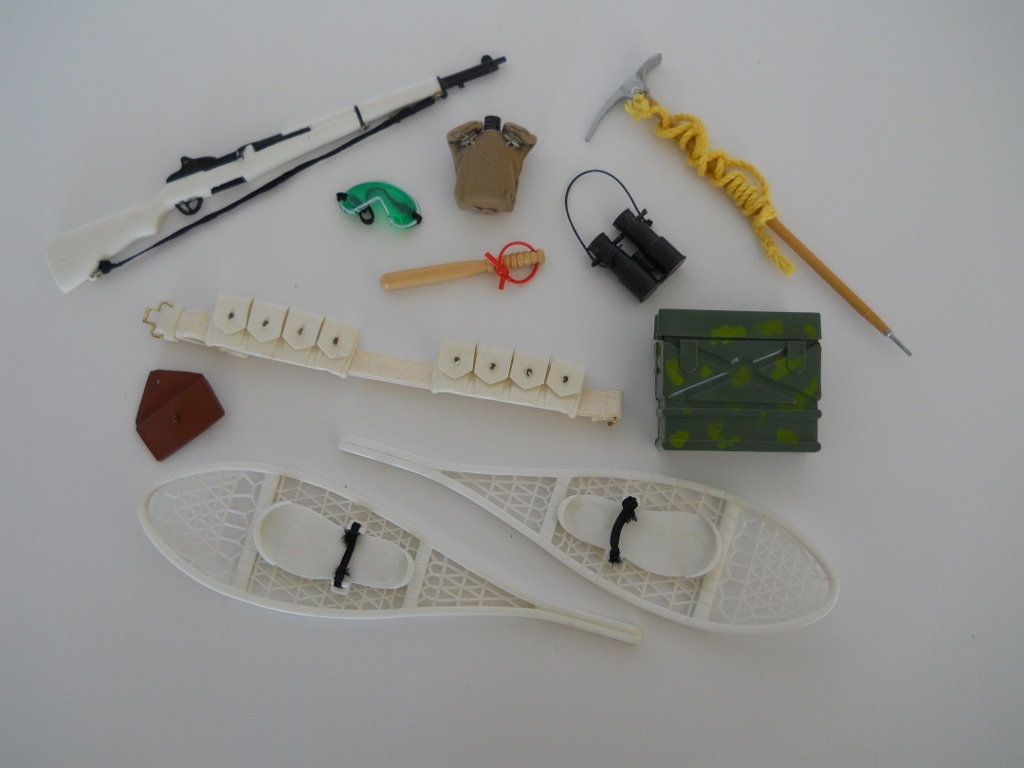
Shown below is a close-up of the elusive "brown" first aid pouch, displayed next to two of the standard Hasbro "green" units.
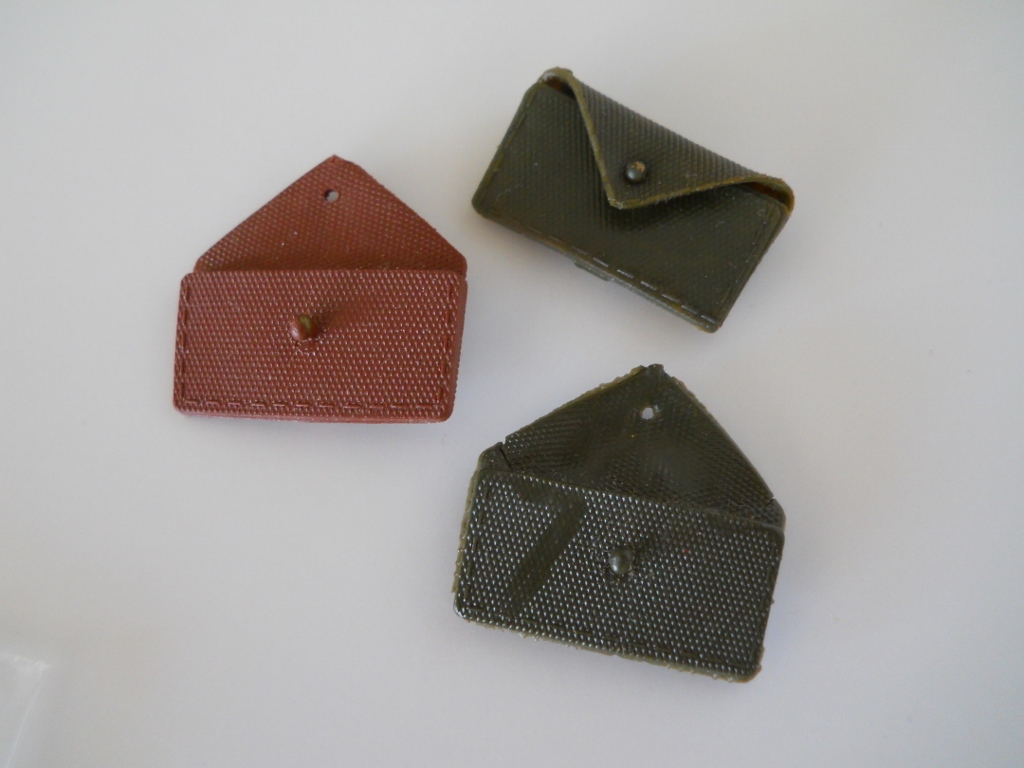
h.) The Corrugated Box
Shown below are a number of images of the corrugated box that the exclusive Simpsons-Sears GI Joe Mountie Gift Set came in.
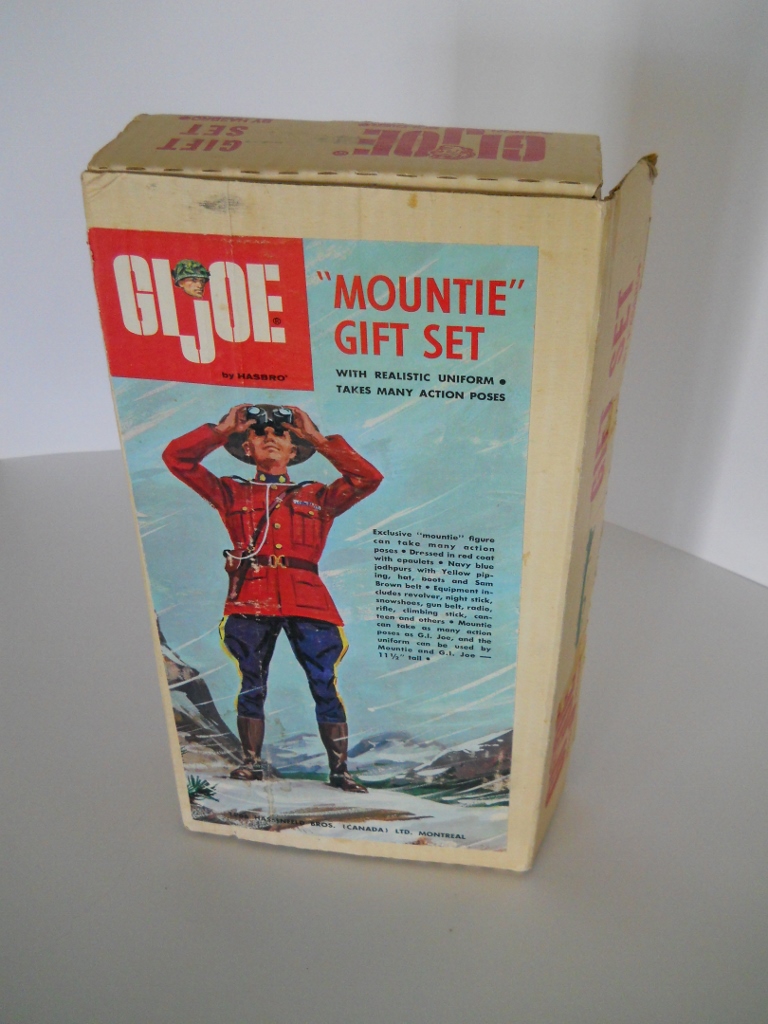
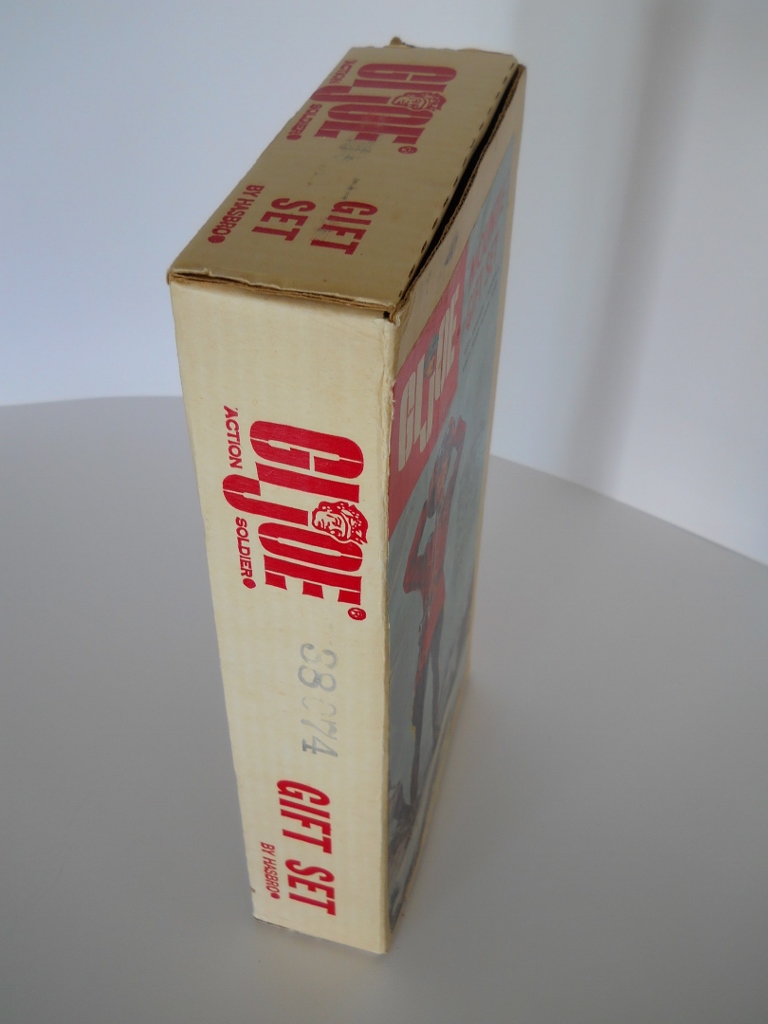
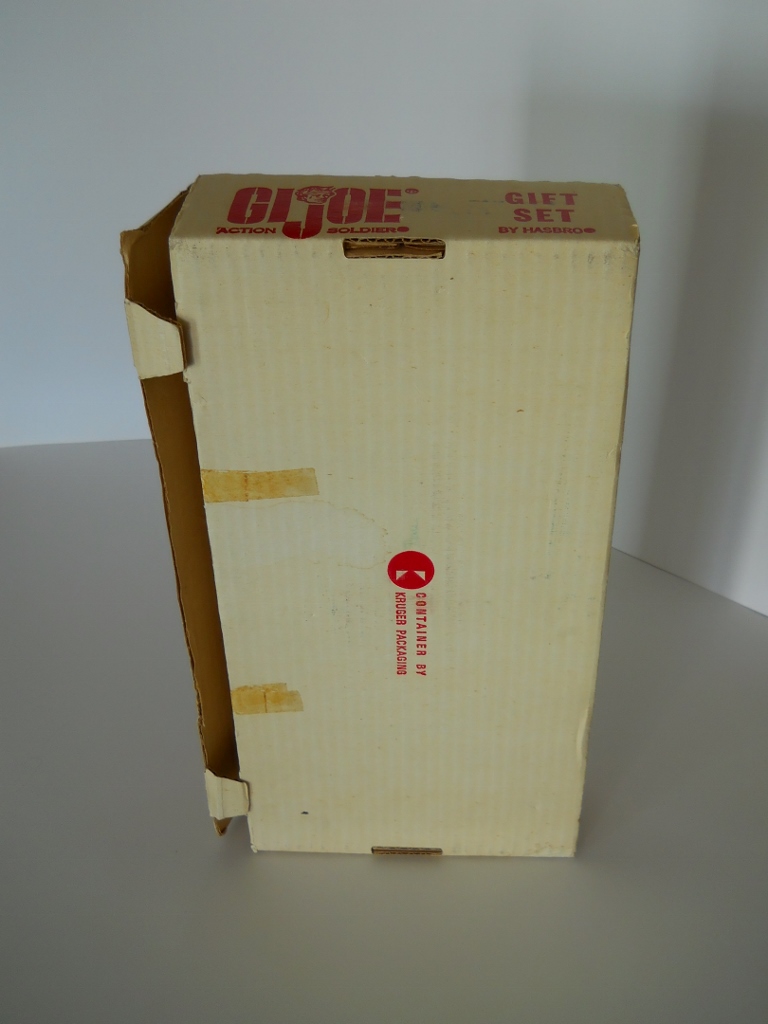


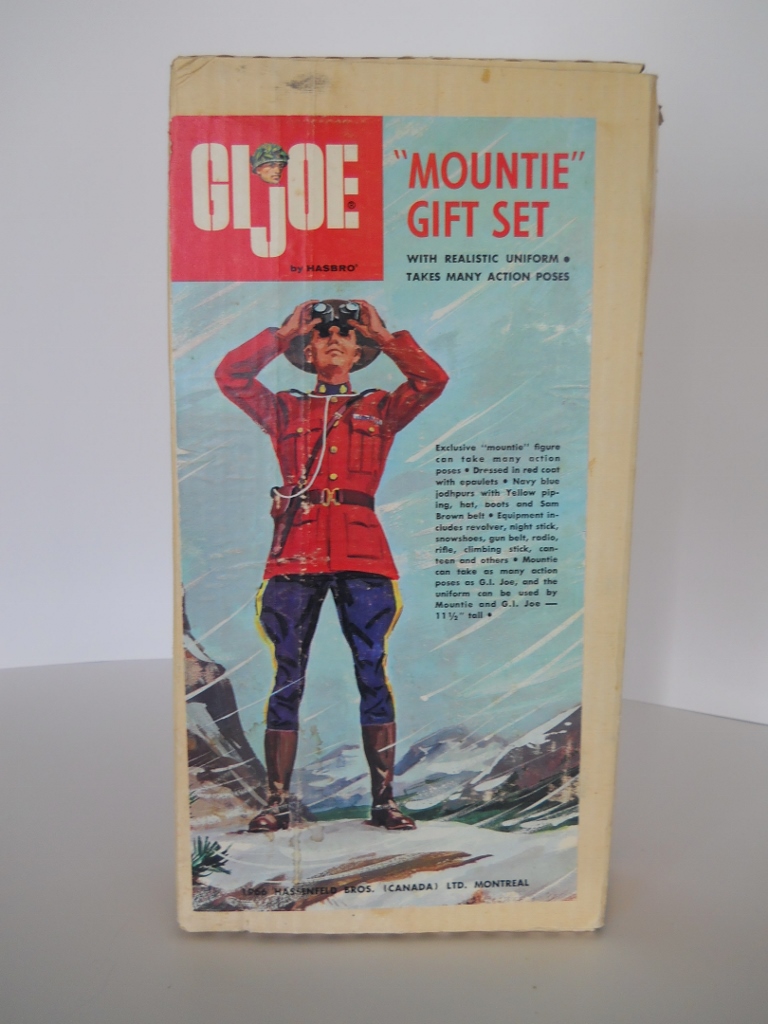
On the back of each box was a logo and the words "Container By Kruger Packaging." On the side of each box, the Simpsons-Sears stock number, 38 074, was stamped with an ink stamp, or, in some cases, the number was simply crudely written on the side in black ink by a Simpsons-Sears employee.
The Palitoy Action Man Mountie
While this article was primarily intended to cover only the 1966-1968 Hasbro Canada Mountie figure, it would be impossible to point out the subtle differences between the Canadian-made uniform and the British-made uniforms without touching base on the Palitoy "Action Man" versions of this figure.
Although the quality, sewing style and coloring can differ widely from one Palitoy Mountie outfit to the next, there were fundamentally only "two" versions of the Action Man uniform that contained any discernible variation. One was the standard "store-bought" uniform and the other was the special order "Mail Away" uniform. I will highlight the features of the "Mail Away" uniform set first.
Shown below are a series of photos of a vintage Palitoy Action Man figure dressed in the "Mail Away" Mountie uniform.
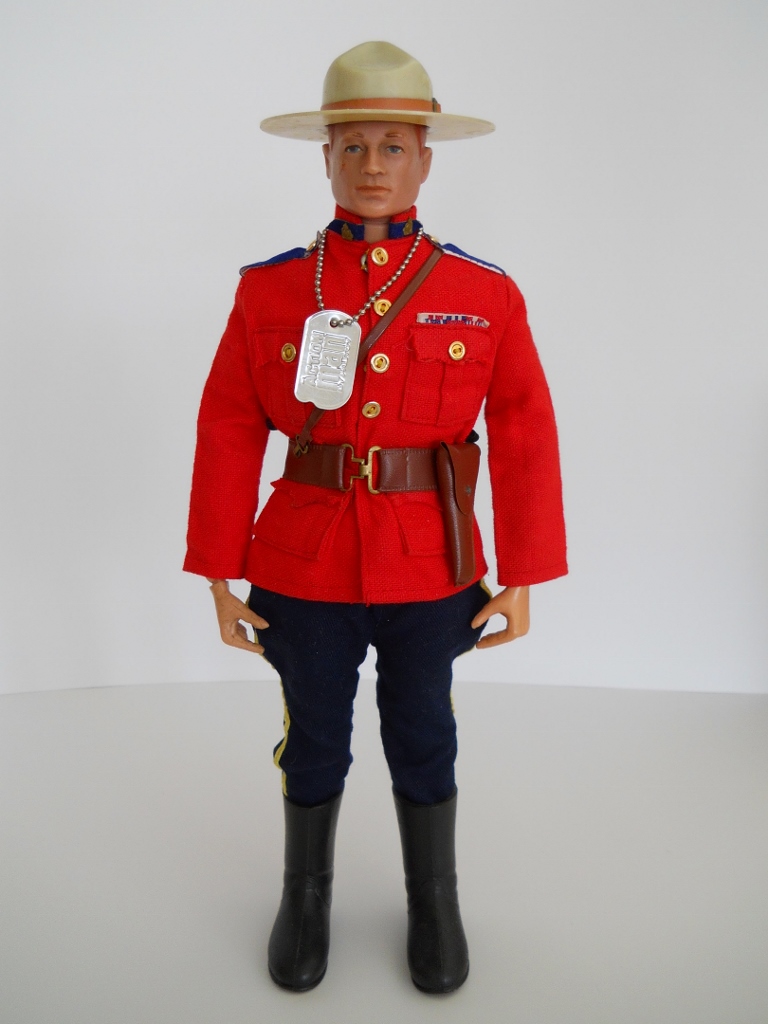
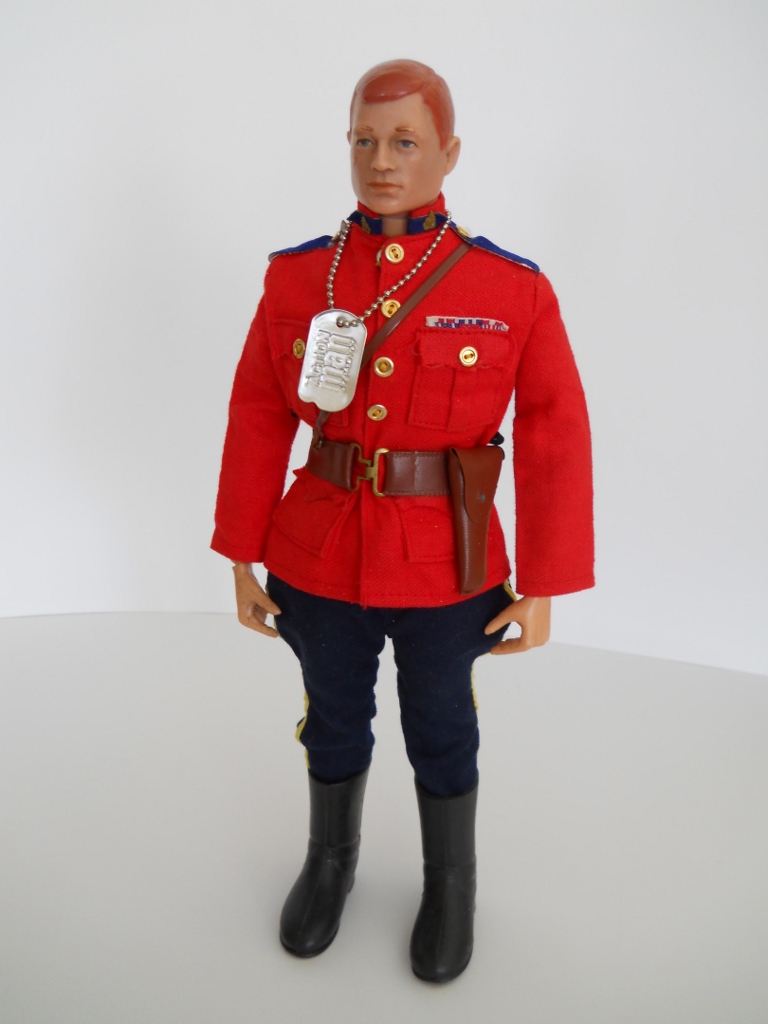
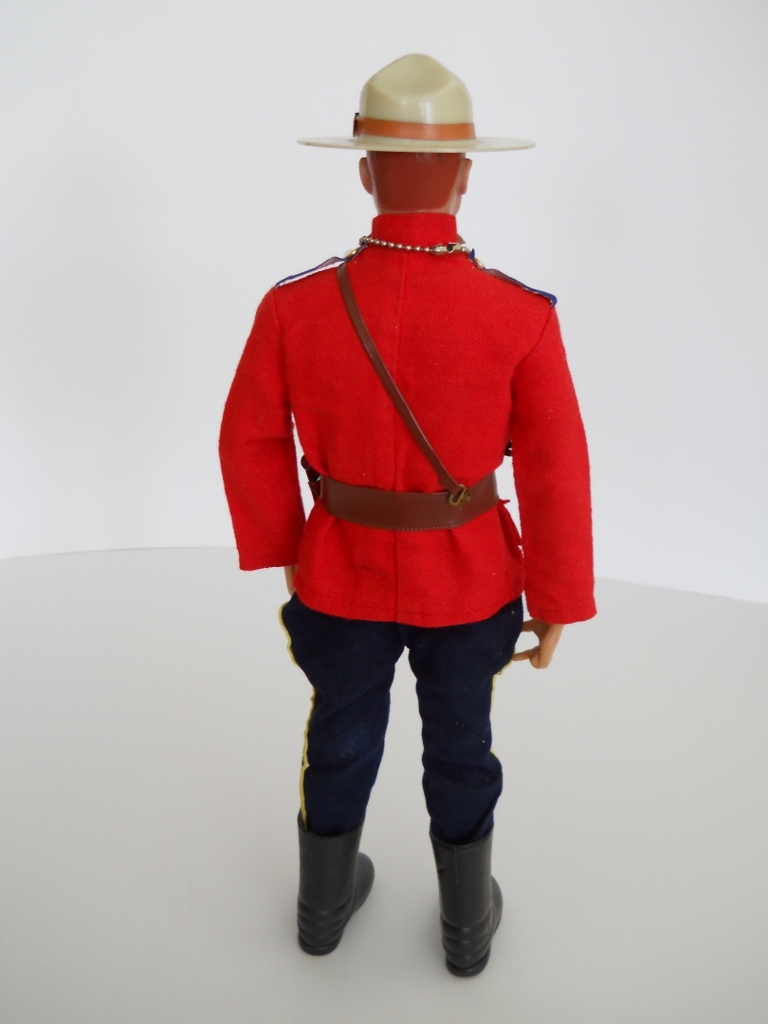
The following topics will highlight the differences between the Palitoy Mail-Away Mountie uniform and the Simpsons-Sears uniform.
a.) The Holster
You can clearly see in the above photos that this figure is wearing a "left" facing holster on his left side. As already indicated, the left-facing holster is an indicator of an Action Man, Geyperman, Action Team or other such foreign make since the Simpsons-Sears holsters were all "right" facing.
b.) The Boots
All Palitoy Action Man Mountie boots were produced in black, not brown.
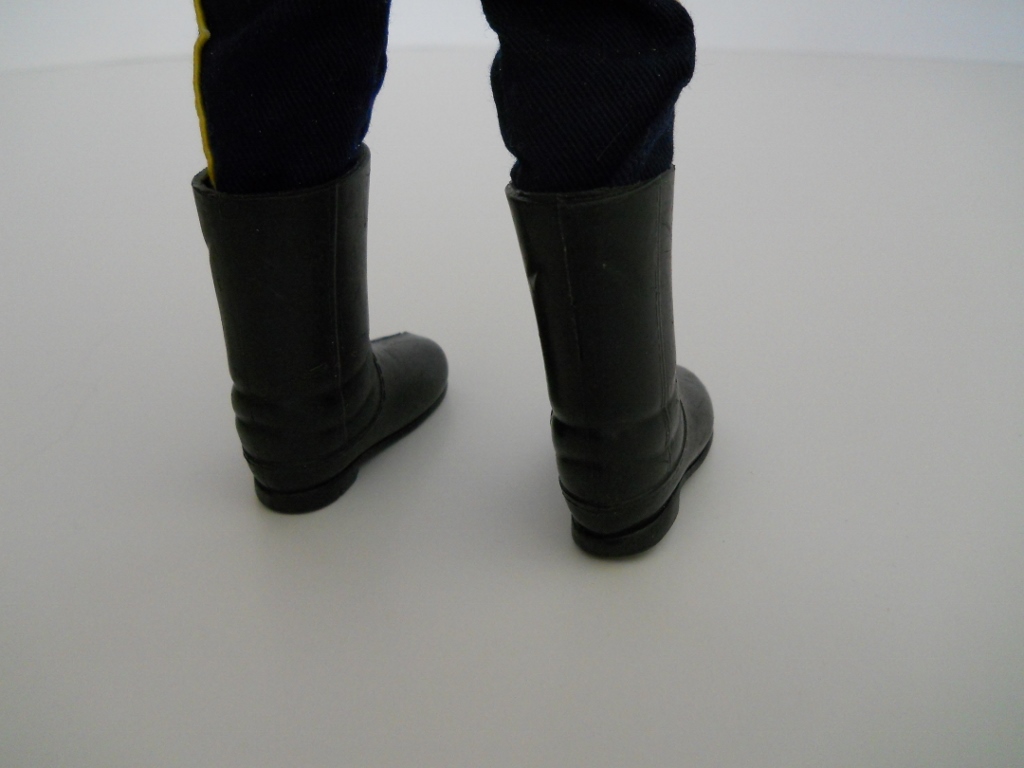
c.) The Jacket
There are four fundamental differences between the Palitoy jacket and the Simpsons-Sears jacket. They are as follows: 1.) The Palitoy jacket contained a "Palitoy Action Man" cloth tag as opposed to a "Hasbro GI Joe" tag, 2.) As with all Palitoy uniforms, the metal snaps used were "round" and not the standard "square" Hasbro snaps, 3.) The Buttons, 4.) The Collar Badges.
The photo below reveals the different style of the Palitoy Mail-Away buttons. You can tell from the photo that they are relatively flat, with raised edges around the perimeter. I like to call these Palitoy buttons the "dinner plate" buttons, as they look like tiny dinner plates.

Below are two photos of the gold buttons for comparative purposes. The Palitoy mail-away "dinner plate" button is shown in the left photo and the Hasbro Canada "cereal bowl" button is shown in the right.


The difference in the collar badges is subtle and you really have to place the two different jackets side by side to clearly discern the difference. But, having said that, the Palitoy collar tab has two or three defining features. First of all, it is wider and shorter than the somewhat narrower and taller Hasbro Canada badge. Second, and most importantly, the Palitoy tab was produced with much less detail than the Canadian collar badge. On the Simpsons-Sears version, you can clearly see the bison's head in the center of the emblem. You can also see a fair bit of detail on the crown at the top of the badge. But, on the Palitoy badge, all the details are blurred and not sharp at all. In fact, the buffalo's head looks just like raised oval "dot" in the middle, with no relief features present. The following picture shows a close-up image of the Palitoy collar badge.

d.) The Jodhpurs
All of the Palitoy Mountie pants that I have seen have lacked a cloth Action Man tag inside of them. Perhaps a few may have been tagged, but most of the other European-issued outfits, such as Geyperman and Action Team, also usually had untagged pants.
e.) The Hat and Hat Band
As previously mentioned in the section above covering the Simpsons-Sears Mountie hat band, the Palitoy hat band has a raised, random pattern within it that looks like the spots on a giraffe. In a similar fashion, Geyperman hat bands also had the same pattern. Hat band colors could vary slightly, but all of the European-made bands were also manufactured in a "tan" color, but not necessarily a uniform "peanut butter" shade like the Simpsons-Sears bands. Still, having said this, if the hat band is any other color, such as dark brown, it is likely a bad knock-off or a homemade band.
The photos below show the Palitoy hat band above and the Geyperman hat band below it.

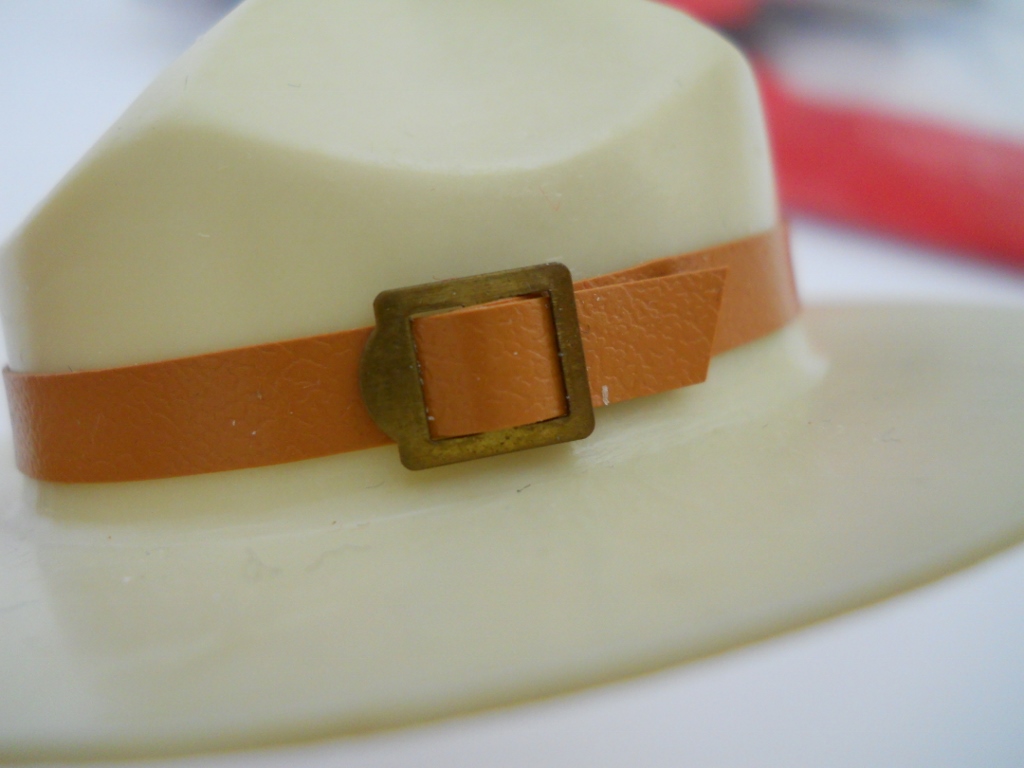
And, as also already mentioned, the composition of both the Palitoy and the Geyperman hats was a hard styrene (model kit type) plastic.
The photos below provide a clearer comparison of the hard plastic Palitoy hat to the soft plastic Simpsons-Sears hat. Notice the thick edge on the Simpsons-Sears hat on the right.


f.) The Revolver and Lanyard
Although the revolver issued with Palitoy figures was the same six-shot Lebel pistol issued with the Hasbro Canada sets, the handle on all of the Palitoy revolvers was painted brown, not black. As already mentioned, the lanyard material was not common string, but usually an elasticized nylon rope.
Below is an image of another 1966 Simpsons-Sears Mountie on the left. On the right is a comparison photo of this figure standing next to the Palitoy "Mail-Away" figure. Notice the difference in the color tone of the two jackets. The Palitoy jacket is much more a "Tomato Red" color as opposed to the darker "Cherry Red" of the Simpsons-Sears figure.

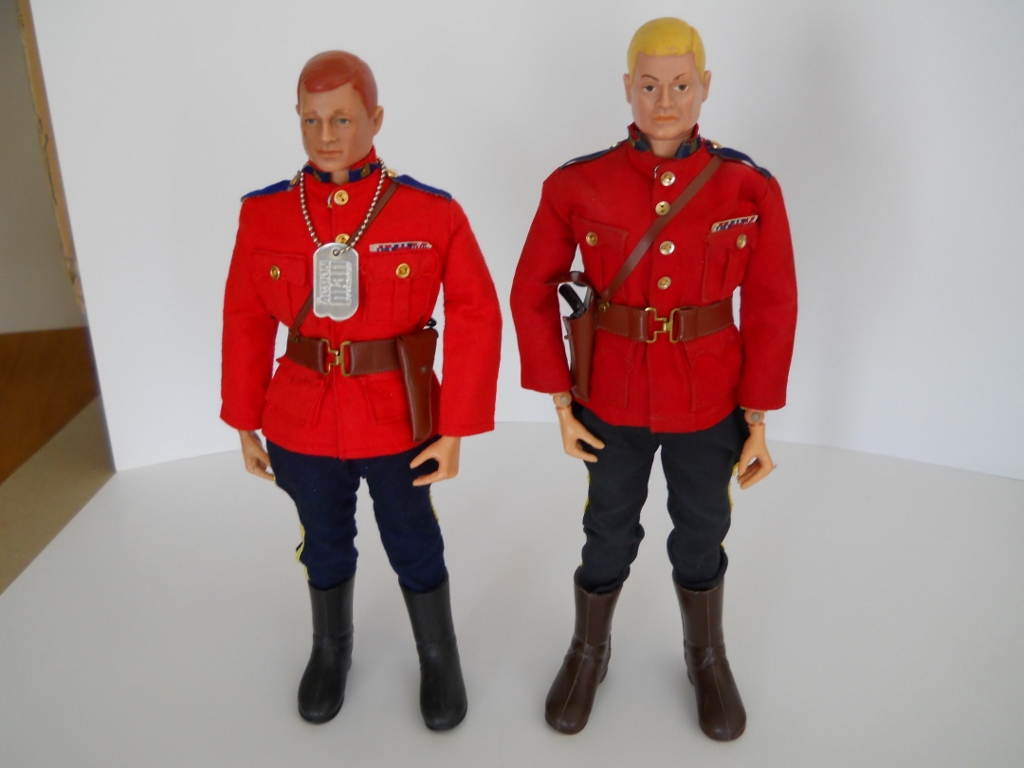
(You will note that the holster on the Simpsons-Sears figure has the flap left open on it. This is because many of the original Simpsons-Sears vinyl holsters have "hardened" over time and, given the fragility and stiffness of this item, I am wary of trying to force it shut.)
After having extensively covered the "Mail Away" version of the Palitoy Mountie, we now have a simpler task in describing the much more common "Store Bought" version. The only difference between the "Store Bought" Palitoy Mountie and the "Mail Away" Palitoy Mountie are the gold buttons on his jacket. (Having said this, there is usually a bit of difference in the quality of the jacket material, too, as I found the Mail-Away version to be of consistently better quality.)
Shown below are a few close-up photos of the standard Palitoy gold Mountie buttons. You will note that they have raised sides on them and that they look somewhat like miniature "Turkish Fez" hats.

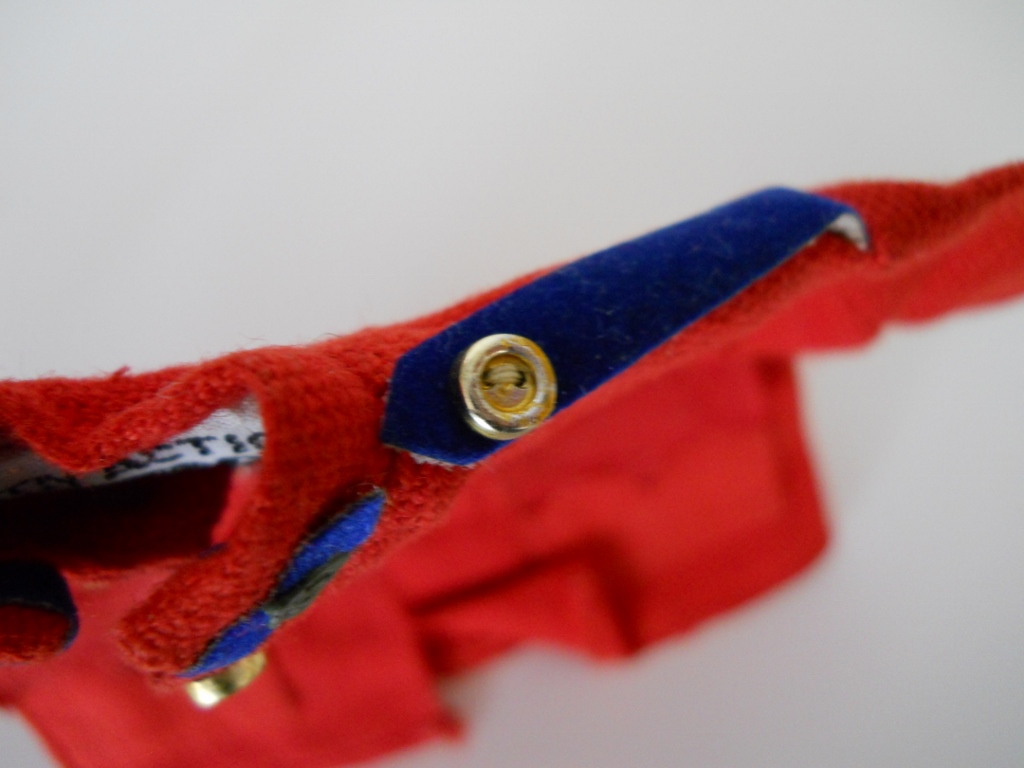
(Special Note: TO ALL U.K. EBAY SELLERS - Before leaving the topic of the Palitoy Action Man, there is one more thing that I really have to say. The name of the Royal Canadian Mounted Police (RCMP) action figure is the Canadian "MOUNTIE." There is no such thing as a "Mounty" . . . unless you mean Mounty Python; I know it's Monty, just giving you a return jab on misspelling!)
Geyper Man
Next, we need to touch briefly on the Geyperman Mountie uniform. The photo below shows the various elements of the Geyperman Mountie uniform set.
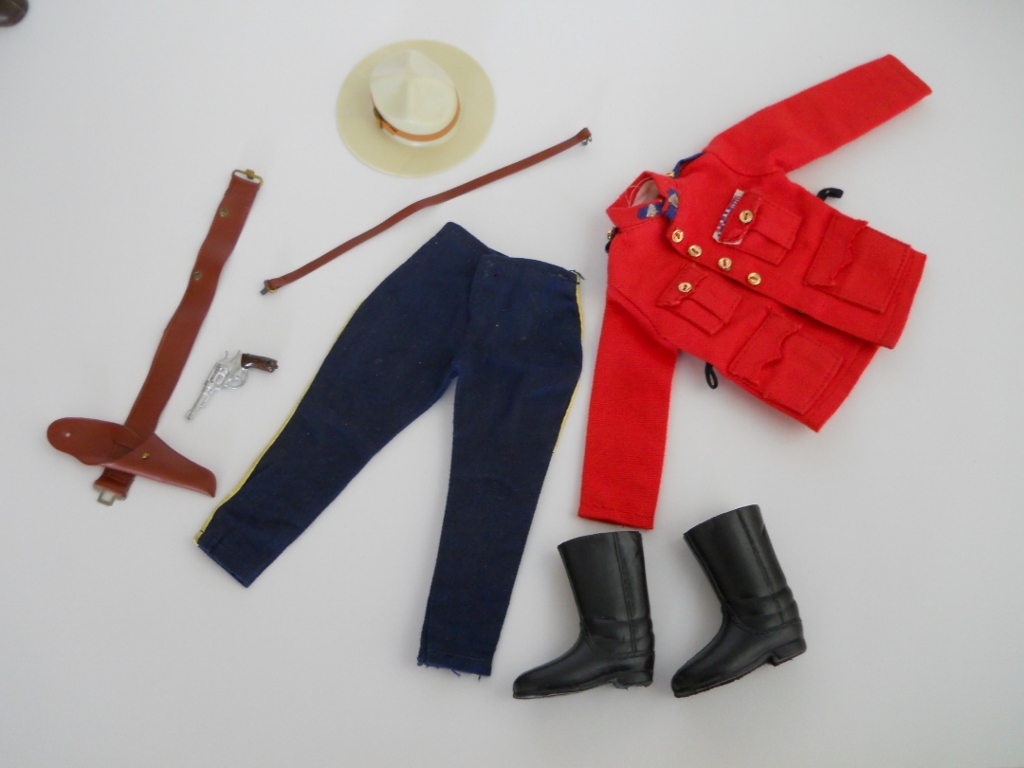
You will note that many of the features of the Geyperman set are identical to the Palitoy versions. Specifically, the black boots, the untagged pants, the brown handle on the revolver, etc. But, there are a number of significant differences, too. Aside from the jacket having a "Geyper Man" nylon tag in it, the two other variant features are, once again, the gold jacket buttons and the collar badges.
The photos below illustrate the nature of the gold jacket buttons. Similar to the standard Palitoy jacket buttons, the Geyperman buttons also have raised sides on them, however these buttons are a bit flatter and broader than the Palitoy versions. I like to call these buttons "dog dish" buttons as they look like miniature canine water bowls.


You will note that there is also another notable difference between the Geyperman jacket and the Palitoy jacket in that the Geyperman version has the standard Hasbro square metal snaps sewn on it, as opposed to the round Palitoy snaps.
Finally, the collar badges are "silver" in color as opposed to the standard gold emblems, but I will hold off on further describing them in detail since they will become an integral component of the following topic.
The 1970's Hasbro Canada Mountie Uniform
Hasbro Canada reissued yet another version of the Mountie uniform in the mid-1970's. The photo below is a picture of the jacket that came with this set.
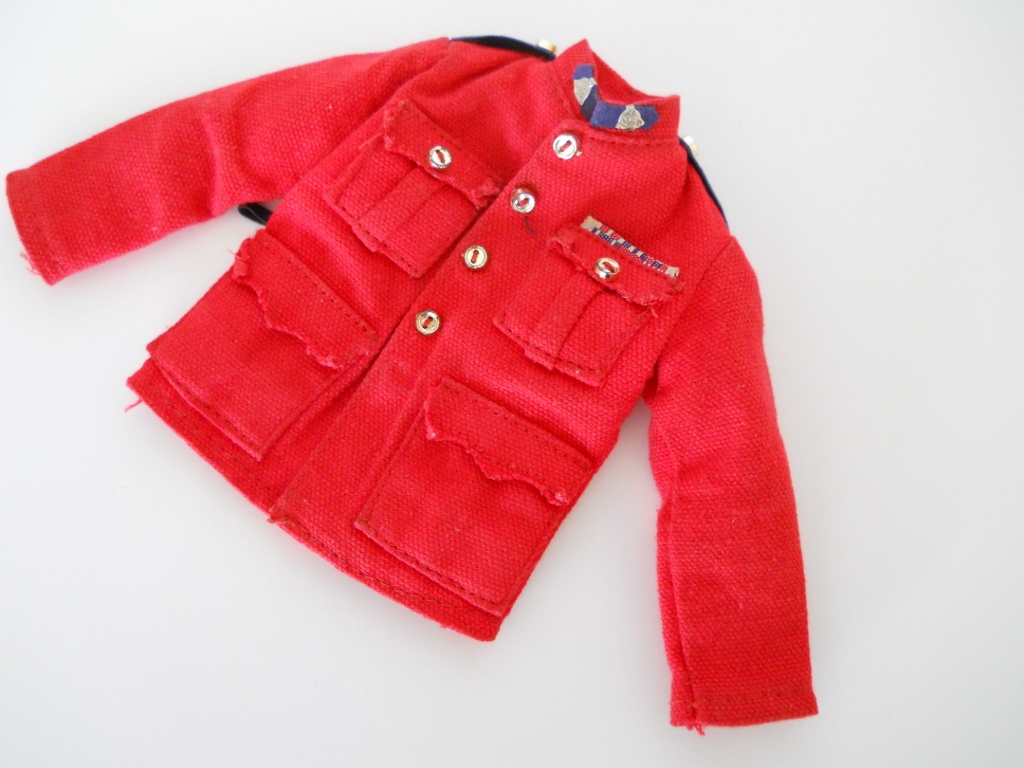
These jackets had the raised "dog dish" gold buttons on them. In addition, the collar badges were "silver" in color and, instead of having the official RCMP bison-head emblem on them, they bore the letters "E.R." in the center of each badge (E.R. standing for "Elizabeth Regina," the "Regina" meaning "Queen" in Latin). The image below shows a close-up of the badge.
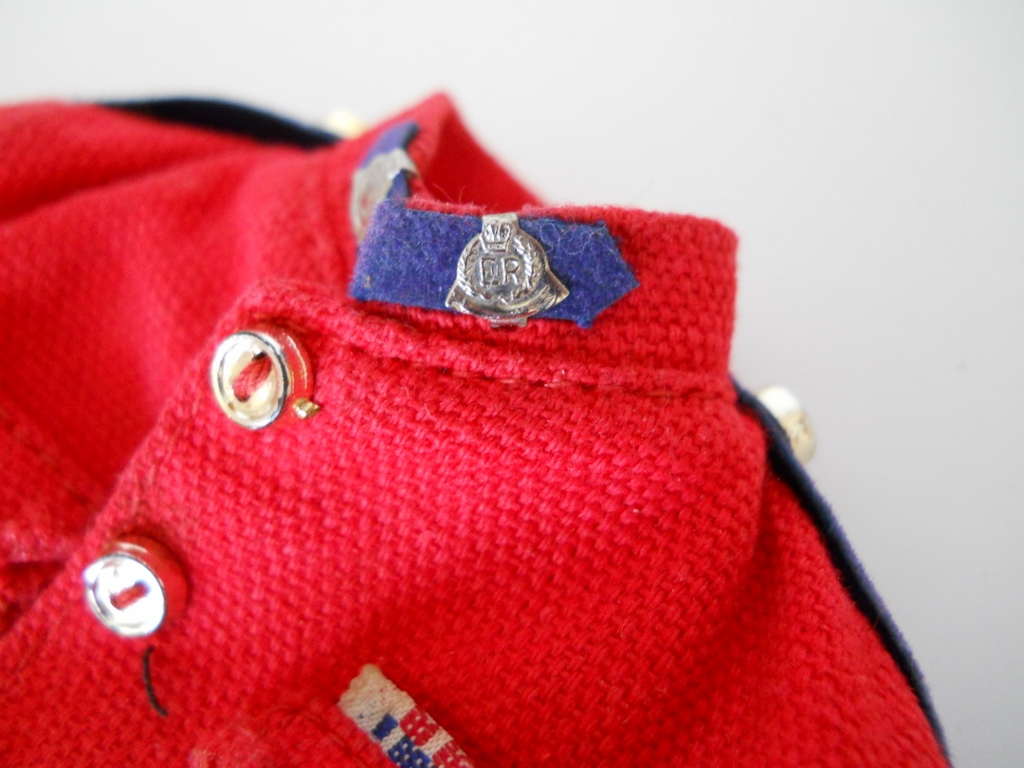

And now, finally returning again to the topic of the Geyperman uniform, let's see of you can guess what the silver collar badges looked like on that particular uniform?
If you guessed that they are identical to those on the 1970's Hasbro Canada uniform, you win a prize!
Not only are the buttons and collar emblems dead identical, but every single feature of the 1970's Hasbro Canada uniform is exactly the same as the Geyperman uniform.
Clearly what likely transpired was as follows. Geyperman produced their version of the Mountie uniform at some point in time in the 1970s. When Hasbro Canada later decided to re-release a Mountie set, the solution was simple. All they had to do was to go to the same manufacturer that Geyperman was using, order a quantity of these same sets, and merely sew a "GI Joe" nylon tag into them instead of a Geyperman tag!
The photo below illustrates a Geyperman jacket on the left and a Hasbro Canada 1970's era jacket on the right. Can you see a difference?

So, Mountie collectors; remember this rule of thumb. Look more closely at the collar badges and gold buttons than at the embroidered or nylon name tags. Remember, tags can be removed and replaced. But, a complete set of the correct buttons or collar badges? Well, they'd likely be a little harder to come across.